

Doc 12
FOI 24-43
OFFICIAL
Environmental Management of Changes to
Aircraft Operations
AA-NOS-ENV-2.100
Version 17
Effective 01July 2022
Prepared:
Endorsed: s47F
Environment & Sustainability Principal Advisor
Authorised: s47F
A/Chief Safety and Risk Officer
by Airservices Australia pursuant to the Freedom of Information Act 1982 (Cth)
Released
Uncontrolled if printed
© Airservices Australia 2022
1 of 38
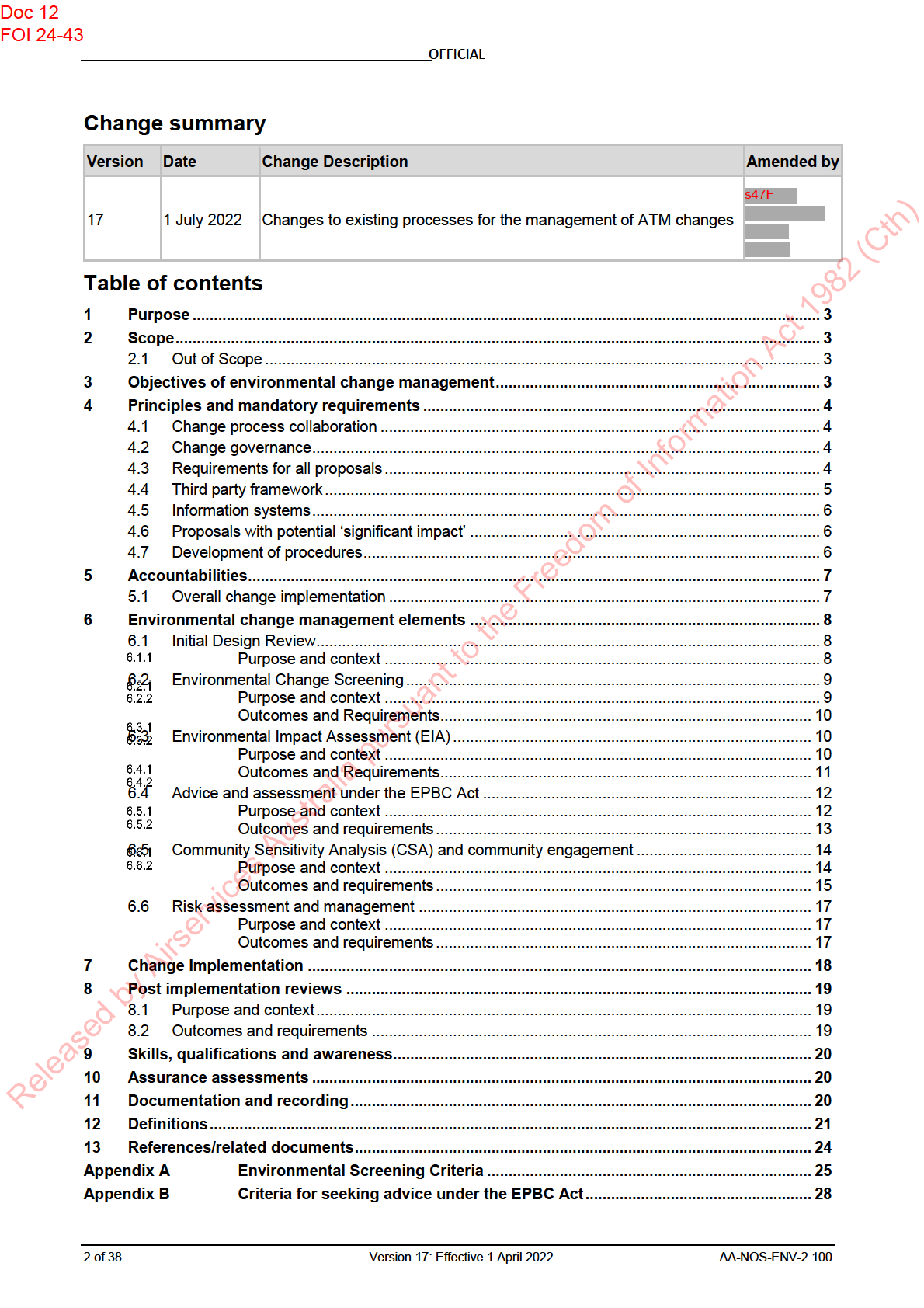
Doc 12
FOI 24-43
OFFICIAL
Appendix C
Other Business Revenue – explanatory notes ........................................................ 38
1
Purpose
The purpose of this Standard is to prescribe the requirements for environmental impact
assessment (EIA), community sensitivity analysis (CSA) and community engagement
that must be met, prior to implementing changes to aircraft operations.
These activities shall be collectively referred to as environmental change management
within this document.
2
Scope
This Standard applies to all proposed changes to air traffic management practices
(proposals) that may involve a change to aircraft operations.
Proposals include, but are not limited to, the following:
new, or amendment to an existing, instrument flight procedure;
new, or amendment to an existing, air route;
re-classification of airspace;
change to noise abatement procedures or preferred runways;
a change that allows use of a flight path/airspace by a different type or quantity of
aircraft;
Note:
A tactical decision of an air traffic controller to alter the track of an individual
aircraft does not constitute a proposal.
Note: Changes involving the administration or facilitation of emergency operations
(aerial firefighting, police, Border Force, military or other covert ops) are not
required to be screened as they are considered inherently tactical.
2.1
Out of Scope
This Standard does not necessarily apply to other business revenue (OBR) work
undertaken by Airservices. For OBR work, an approach shall be determined by the
Chief Service Delivery Officer, to assess the potential application of the
Environmental
Protection and Biodiversity Conservation Act 1999, and the potential environmental
impact of the work.
Refer to Appendix A for applicable changes and Appendix C for further information
regarding OBR work.
3
Objectives of environmental change management
by Airservices Australia pursuant to the Freedom of Information Act 1982 (Cth)
Recognising that safety is our most important consideration, the main objectives of
environmental change management for aircraft operations are to:
1.
meet our legislative obligations to:
a.
avoid ‘significant’ environmental impacts resulting from any Airservices
Released
action, and ensure appropriate regulatory consideration and impact
assessment, as required under the
Environmental Protection and
Biodiversity Conservation Act 1999 (the EPBC Act).
AA-NOS-ENV-2.100
Version 17: Effective 1 April 2022
3 of 38
Doc 12
FOI 24-43
OFFICIAL
b.
ensure air traffic management practices are conducted in a manner that
protects the environment, as far as is practicable, as required under the
Airservices Act 1995;
c.
meet applicable Ministerial Directions relating to aircraft noise
management;
2.
minimise our business risks by maintaining effective community engagement and
sound corporate citizenship in aircraft noise management;
3.
provide a standardised and rigorous approach to assessing the impacts of
changes to aircraft operations, as a demonstration of organisational due diligence
in environmental management (in compliance with the requirements of our
Environmental Management System (EMS) - as described in
AA-NOS-ENV-0001);
4.
assist in achieving organisational environmental, sustainability and community
management commitments (as described in our Environmental Policy
C-POL0030); and
5.
assist in achieving efficiency outcomes for our customers, through improved flight
paths and associated reductions in fuel costs and emissions.
4
Principles and mandatory requirements
4.1
Change process collaboration
Environmental change management is a collaborative process involving impact
assessment (environmental, social and reputational); risk assessment and
management; and community engagement.
These management elements shall be conducted collaboratively and concurrently by
relevant parties throughout the change lifecycle, such that flight paths are designed
and implemented in a manner that minimises environmental and community impacts to
the greatest extent practicable.
4.2
Change governance
A formal standing change governance panel shall be established with representation
by accountable managers from all business units with accountability for elements of the
end-to-end airspace/aircraft operations change management. This change governance
panel shall oversee the entire change pipeline from initial proposals to post
implementation reviews, and authorise progress at key decision points established in
this Standard. Decisions of the governance panel shall have minutes and attached to
the CIRRIS change record as evidence.
by Airservices Australia pursuant to the Freedom of Information Act 1982 (Cth)
The roles and responsibilities of the governance panel13 shall be published as a
functional group procedure or a Terms of Reference, which defines membership,
decision making and delegations.
4.3
Requirements for all proposals
Released
All proposed changes to our air traffic management practices that may affect aircraft
operations shall:
13 The governance panel is currently implemented as the ‘Airspace Governance Panel’ described in ATS-PROC-0147.
4 of 38
Version 17: Effective 1 April 2022
AA-NOS-ENV-2.100
Doc 12
FOI 24-43
OFFICIAL
1.
be undertaken in accordance with this Standard and subordinate procedures,
while being commensurate and scalable to the complexity of the change;
2.
be assessed for environmental and community impacts prior to implementation
3.
be designed to avoid environmental and community impacts to the greatest
extent practicable (whilst prioritising operational safety);
4.
involve community engagement prior to the final decision, where potential
community or environmental impacts are identified;
5.
be reassessed14 and reengaged with the community prior to implementation, if
the proposal has already been impact assessed in accordance with this Standard
and:
a.
has subsequently been substantially modified or;
b.
over 24 months has elapsed since the original assessment and
engagement.
6.
undertake a gap analysis for the assessments which were previously endorsed
through a formal Environmental Impact Statement (EIS) or Major Development
Plan (MDP) process to ensure assessment metrics used in the originally
endorsed EIS/MDP adequately addresses the current environmental impact
standard and industry practice, and to determine whether additional advice is
required from the Environment Minister regarding whether the proposal presents
the potential for ‘significant impact’ under the EPBC Act. Refer to Guide ENV-
GUIDE-0028
Environmental Impact Assessment of Changes to Aircraft
Operations for more details about the content and process of ‘gap analysis’.
7.
seek to achieve an outcome that balances the needs of the environment,
community and aviation industry stakeholders, in accordance with Airservices
Flight Path Design Principles (FPDP).
Note: For third party assessments, Flight Path Design team (FPD) shall review and
lodge Environmental Change Screenings in CIRRIS. Safety & Environmental
Assessments team will undertake endorsements, and Community Engagement team
will ensure if communities have been appropriately engaged.
4.4
Third party framework
Airservices Third Party Framework (TPF) procedure (C-PROC0429: Third Party
Proposed Change Management Procedure) shall be applied to all proposals led by a
third party (an Airport for example) where Airservices is in a supporting or joint
development/delivery role. The TPF clearly defines Airservices airspace and flight path
change obligations and the requirements identified through this Standard.
A Third Party Change Management Plan (TPCMP) is required to be completed as part
of the TPF. This plan identifies roles and responsibilities against these obligations and
by Airservices Australia pursuant to the Freedom of Information Act 1982 (Cth)
requirements, and confirms input, review, approval and assurance requirements for
both parties. The TPCMP shall be completed prior to any Airservices activity
commencing on the proposed change.
Released
14 ‘Re-assessment’ is scalable depending on the extent of the given variation to the change, and may only consist of validation of
original inputs and assumptions.
AA-NOS-ENV-2.100
Version 17: Effective 1 April 2022
5 of 38
Doc 12
FOI 24-43
OFFICIAL
4.5
Information systems
The Corporate Integrated Reporting and Risk Information System (CIRRIS)
Management of Change (MOC) module must be used to record case workflows and
due diligence activities associated with a change proposal.
The Environment & Sustainability Principal Advisor is accountable for ensuring that
CIRRIS accurately codifies the screening and assessment criteria and logic described
at Appendix A of this Standard.
If CIRRIS functionality is unavailable, the Accountable CSDO Manager shall ensure
that change proposals are documented in a manner that conforms to the criteria and
process steps outlined in this Standard.
The end to end CIRRIS processes can be completed by Flight Path Design (FPD) on
the basis they provide evidence that the decision has been supported by the change
governance panel or other relevant risk delegate/s.
4.6
Proposals with potential ‘significant impact’
Wherever practicable, Airservices shall seek to avoid changes with the potential to
result in ‘significant impact’ to the environment, as defined under the EPBC Act.
Where avoidance of potentially significant impact is not practicable (e.g. due to a clear
safety imperative), the proponent of the change shall seek advice from the
Commonwealth Environment Portfolio Minister (the Environment Minister), in
accordance with Sections 28 and 160 of the EPBC Act, prior to implementing the
change. Refer to Section 6.4 for further information regarding advice and assessment
requirements under the EPBC Act.
4.7
Development of procedures
Airservices business groups with accountabilities for planning and implementing
changes to aircraft operations shall develop procedures and other supporting
documents that describe:
a.
the internal business processes required to enact the requirements of this
Standard (including interactions with other business groups and external
stakeholders);
b.
the relevant methodologies for undertaking environmental impact assessments,
community sensitivity analyses and community engagement (as required by this
Standard), and how they will collaboratively inform flight path design;
c.
the Flight Path Design Principles (FPDP) applicable to the design of all new and
amended flight path changes to ensure balanced consideration of customer,
community, environment and operational requirements, having first given regard
by Airservices Australia pursuant to the Freedom of Information Act 1982 (Cth)
to safety
d.
Any additional standards, principles and templates applicable to the development
of products or processes defined in this Standard, such as Flight Path Design
Principle Report (FPDPR).
Released
6 of 38
Version 17: Effective 1 April 2022
AA-NOS-ENV-2.100
Doc 12
FOI 24-43
OFFICIAL
5
Accountabilities
5.1
Overall change implementation
The following abbreviations for accountable personnel are used throughout this
standard:
Chief Executive Officer (CEO)
Chief Service Delivery Officer (CSDO)
Chief Customer Experience and Strategy Officer (CCXSO)
Chief Safety & Risk Officer (CSRO).
The CSDO group holds ultimate accountability for ensuring that no change proposal is
implemented without completion of the appropriate environmental change management
requirements, in accordance with this Standard.
In practice this means:
managing the change process to ensure that all assessment and management
elements are completed and approved by relevant managers;
accepting or rejecting risk assessments produced during the environmental
change management process (in accordance with Risk Management Standard
(AA-NOS-RISK-0001), Environmental Risk Management Procedure (ENV-
PROC-0004) and Airspace Change Process (ATS-PROC-0147).
approving implementation of the change once all environmental change
management requirements (as described in this Standard and any change
specific plans) have been met.
The Accountable CSDO Manager is the point of accountability for the overall success
of a change. The Accountable CSDO Manager is either:
the Head accountable for the operations to which the change pertains; or
the Chief Service Delivery Officer (if the proposed change represents a risk in the
‘High’ risk class (in accordance with AA-NOS-RISK-0001) as indicated by the
environmental or community sensitivity analysis and/or the airport risk rating15).
Environmental change management shall be integrated with the overall change
governance framework. Accountable managers from all business groups involved in
the change process must be informed of potential environmental and community risks
and benefits from a proposed change at relevant decision points throughout the
change lifecycle16; including the design and initial proposal stage. See Airspace
Change Process (ATS-PROC-0147).
The CEO holds the ultimate approval authority for change implementation. The change
governance panel must ensure that the CEO is kept informed of the change program
and of any high risk changes prior to implementation.
by Airservices Australia pursuant to the Freedom of Information Act 1982 (Cth)
Released
15 To enable this, CSDO group shall maintain a risk in CIRRIS which describes ongoing environmental risks associated with noise
management at specific Airports, in addition to assessing the risk of the particular change.
16 ATS-PROC-0147 establishes the Airspace Governance Panel (AGP) which meets the intention of this requirement.
AA-NOS-ENV-2.100
Version 17: Effective 1 April 2022
7 of 38
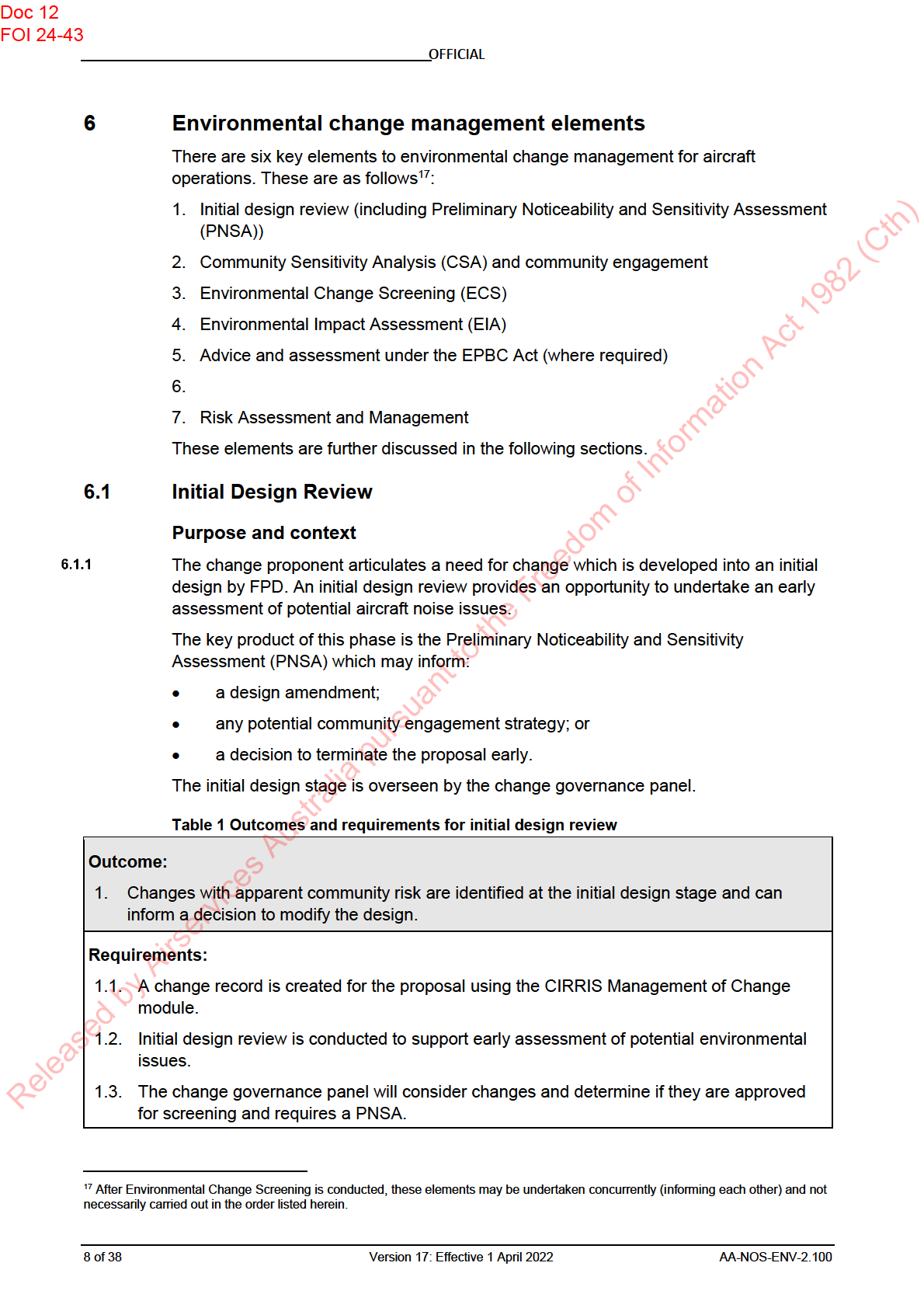
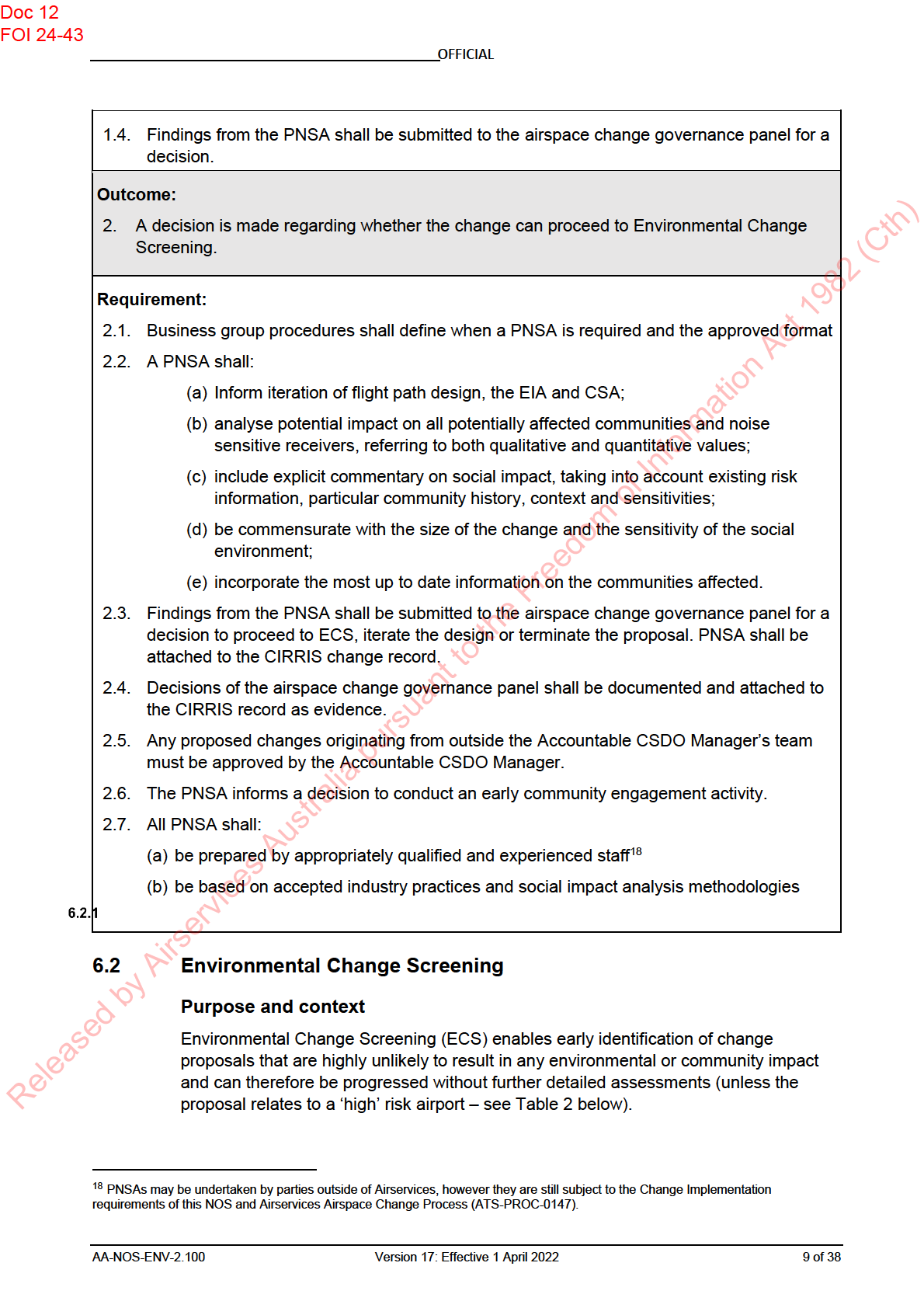
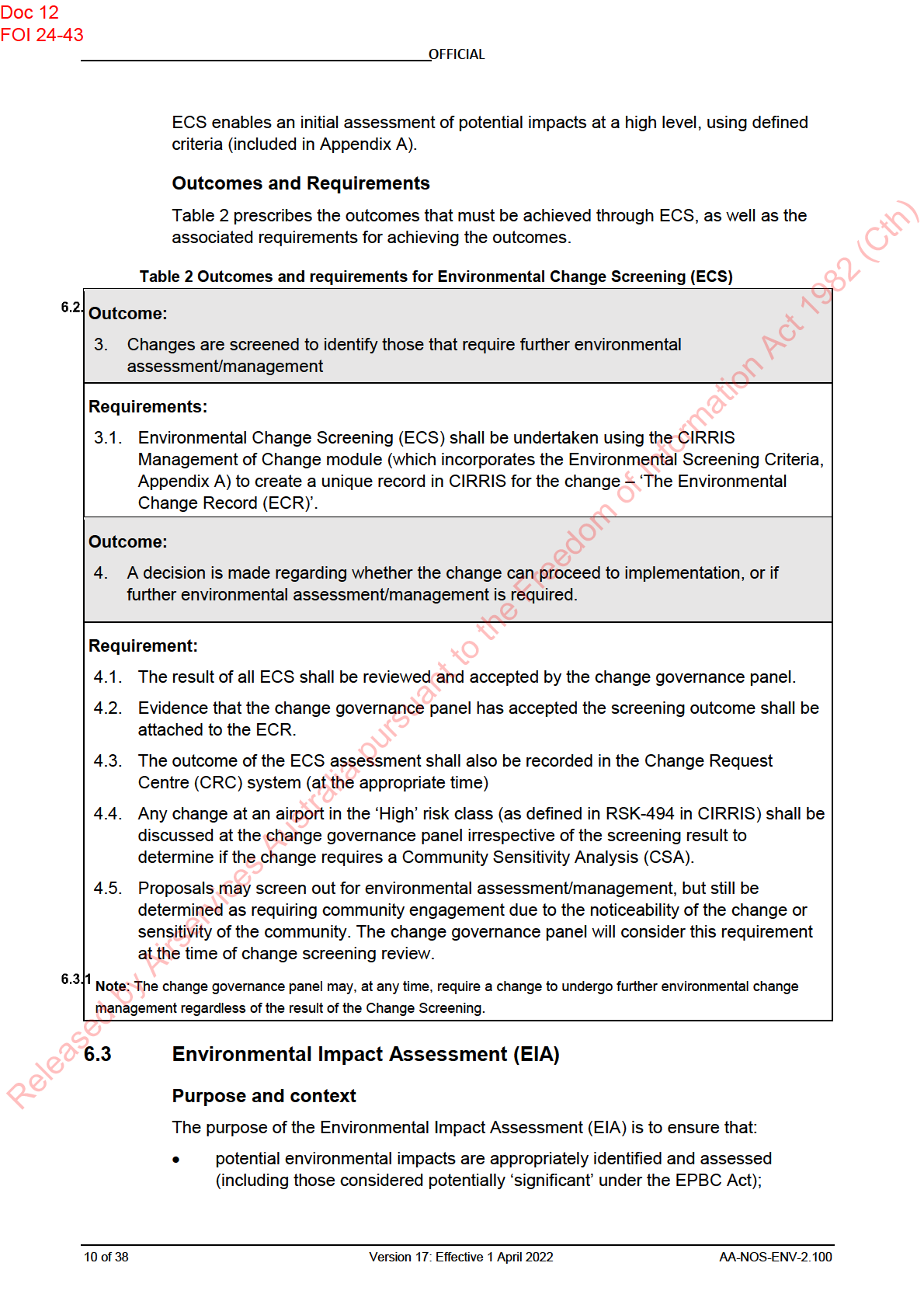
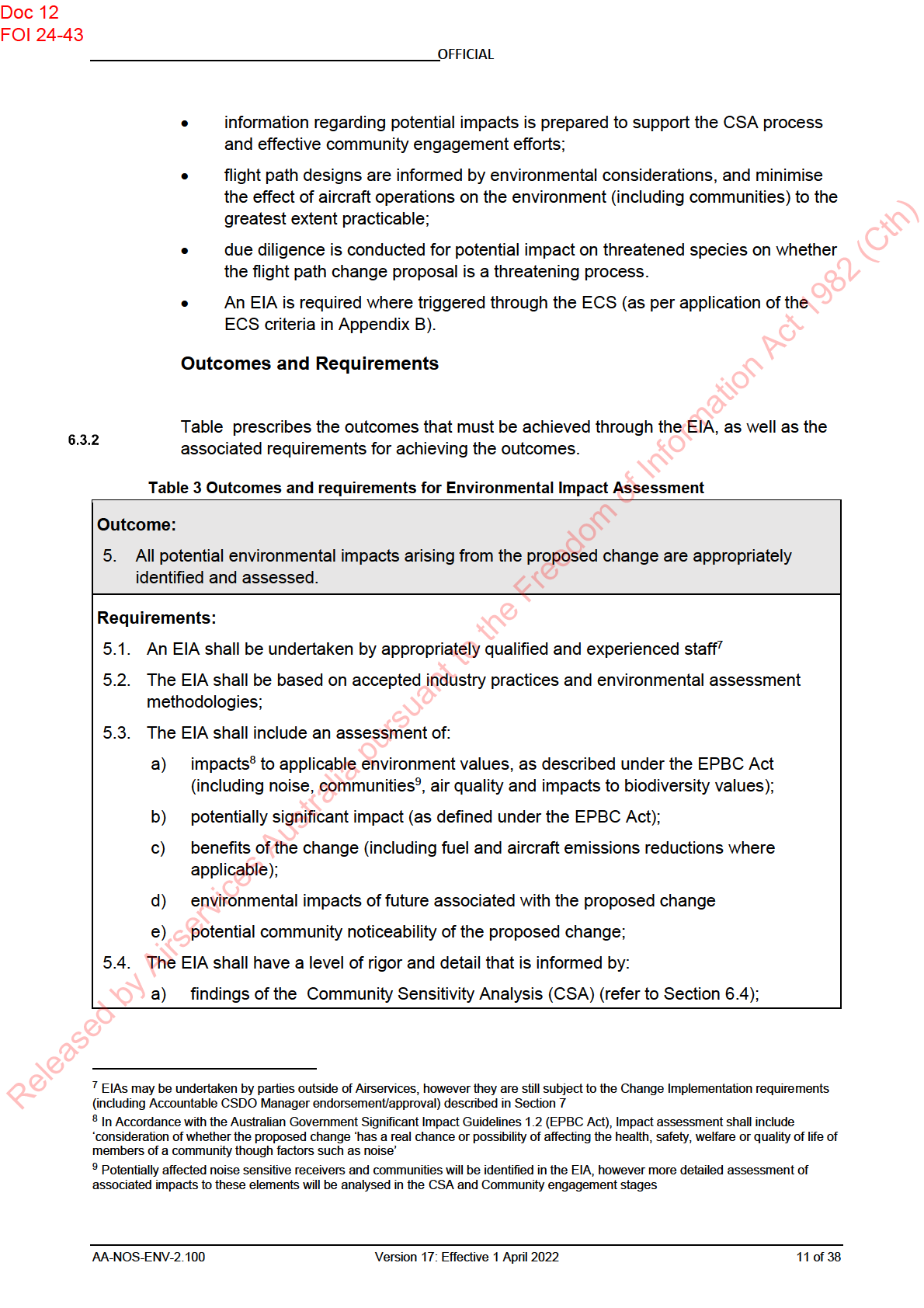
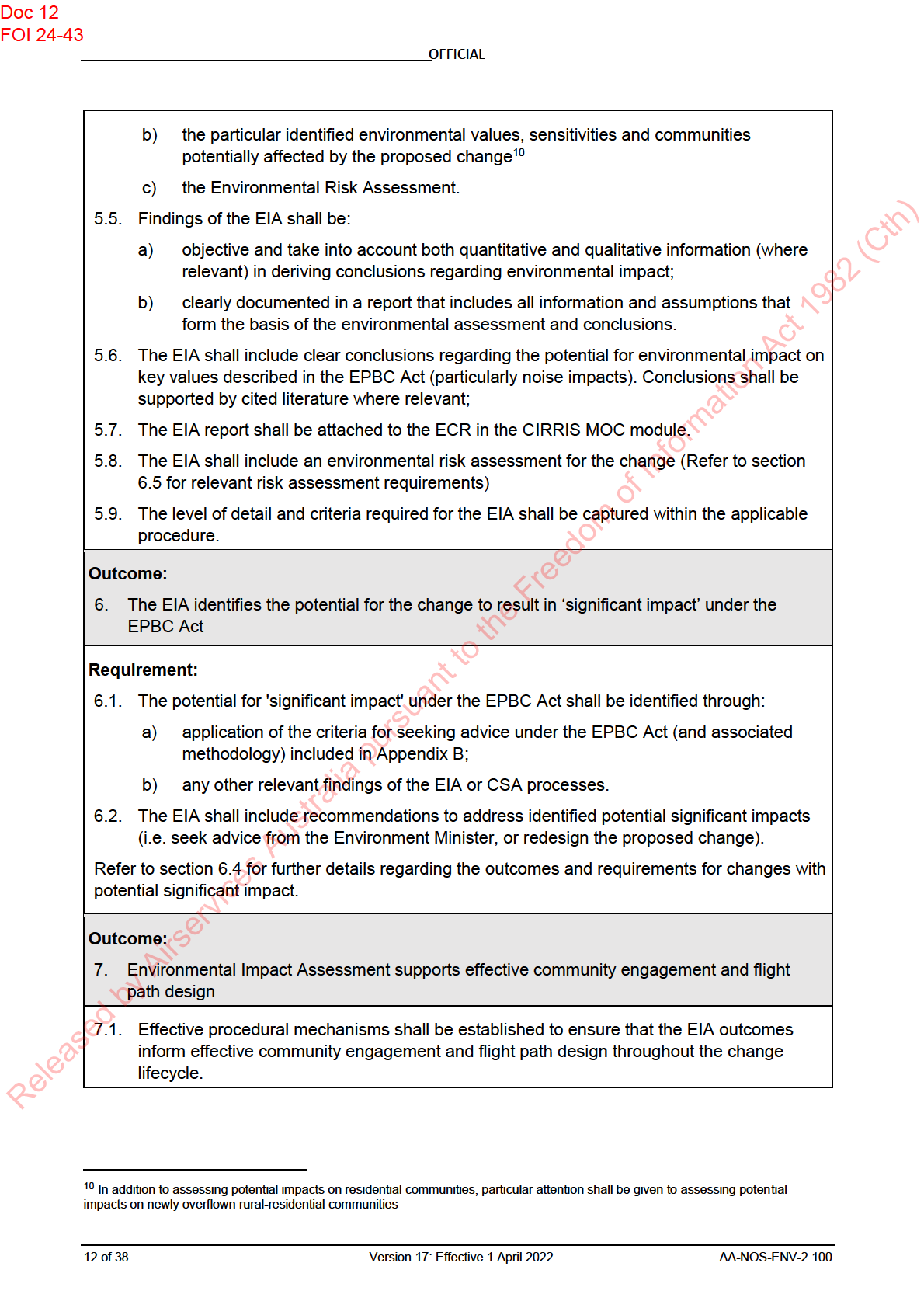
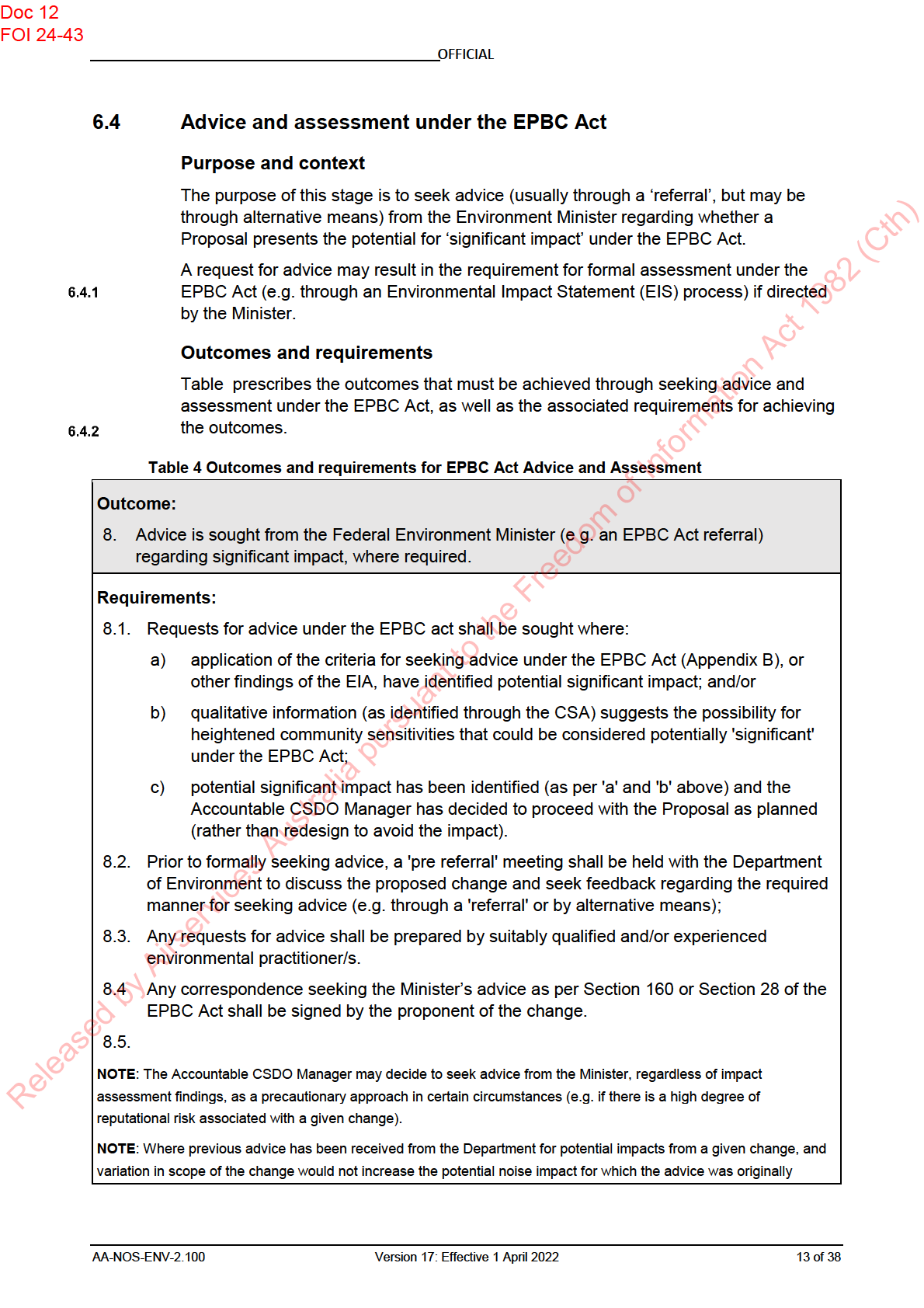
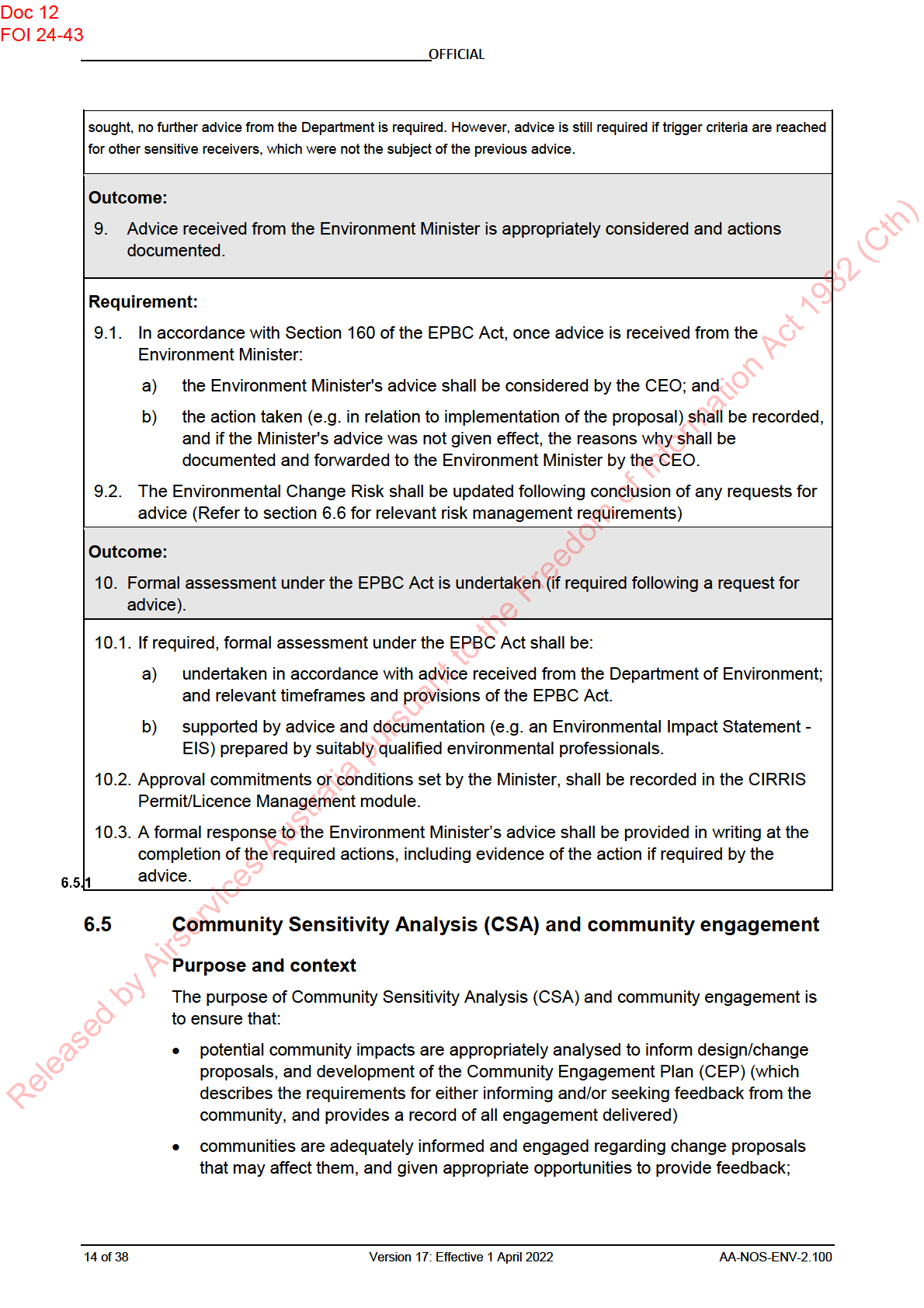

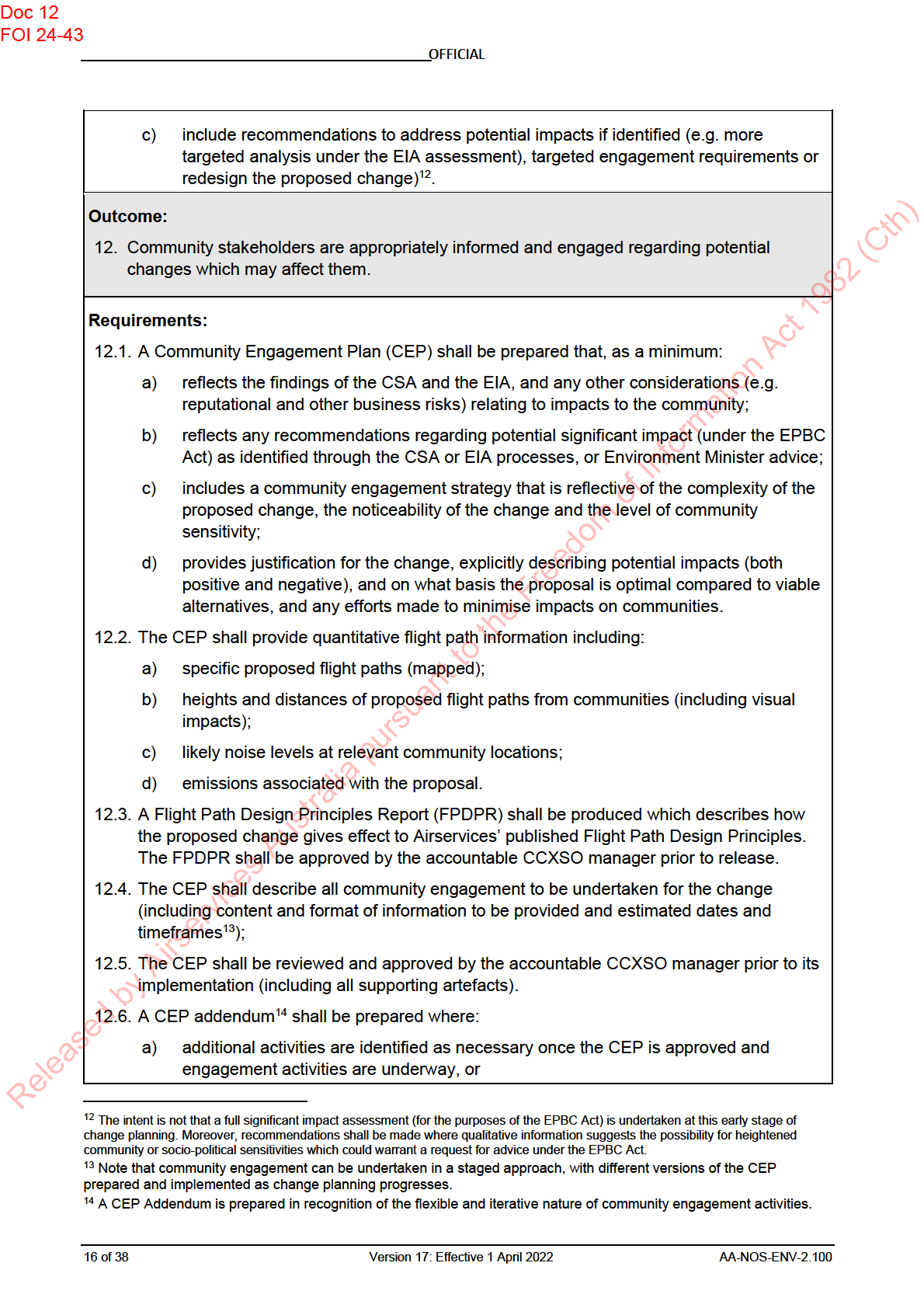
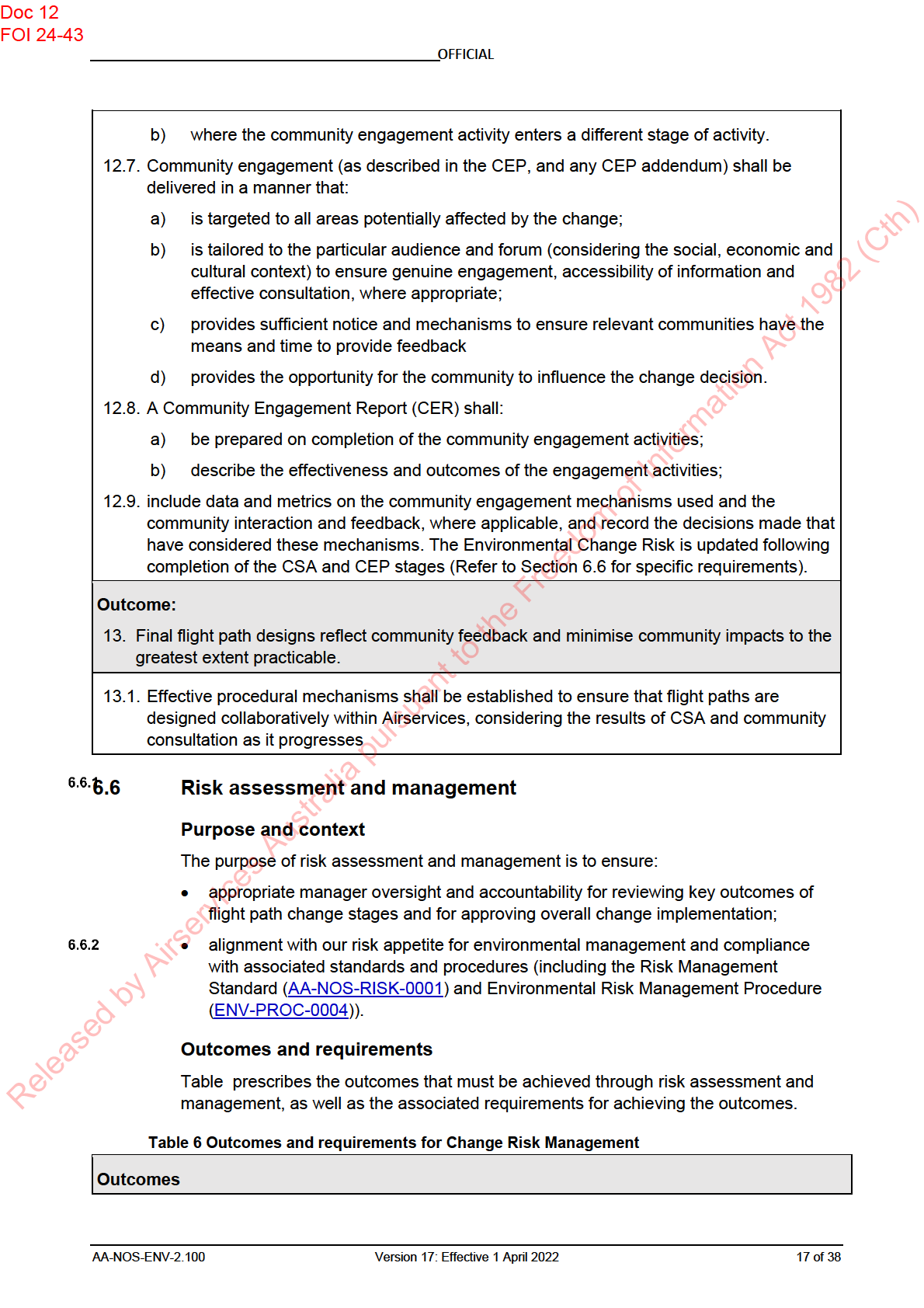
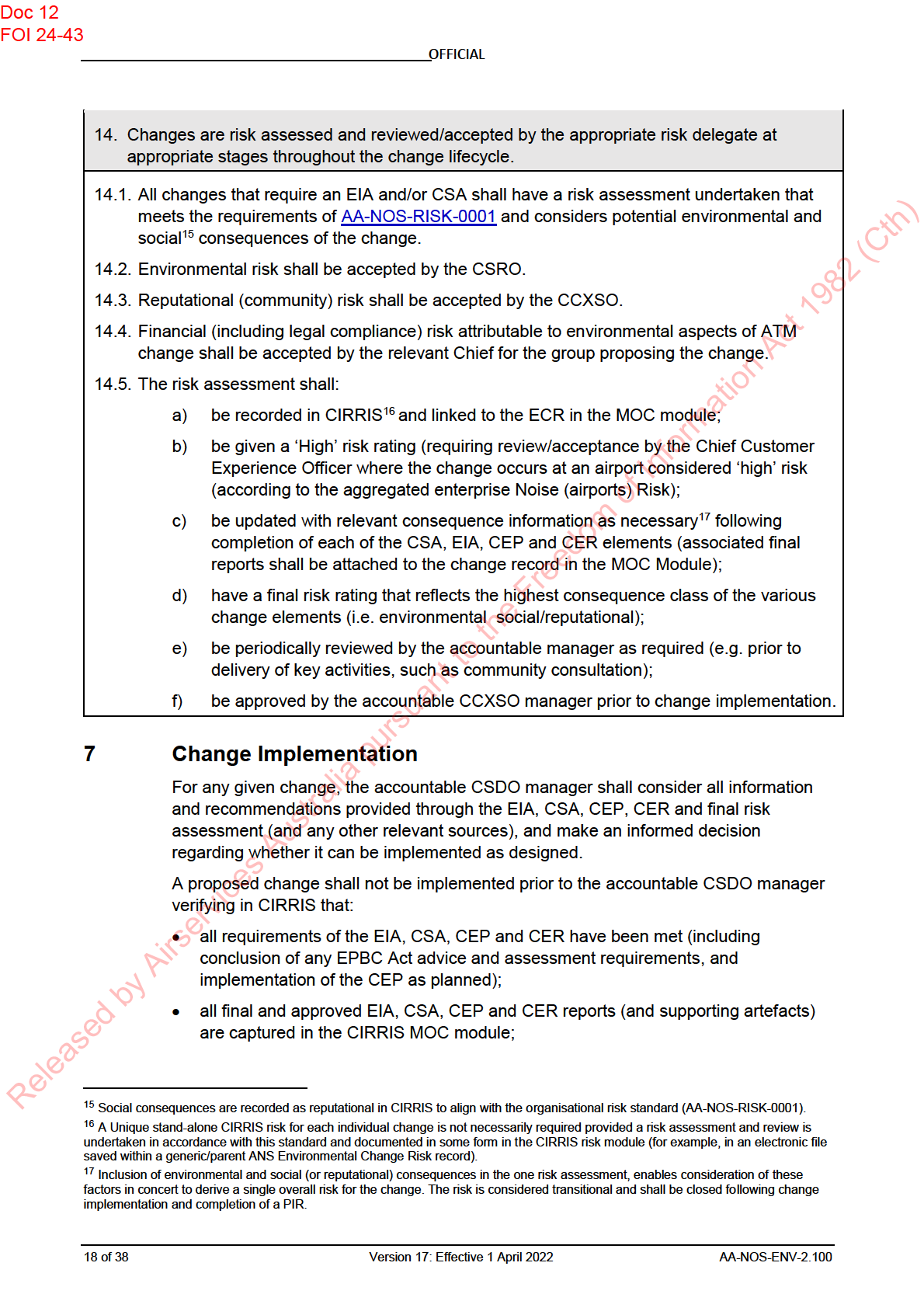
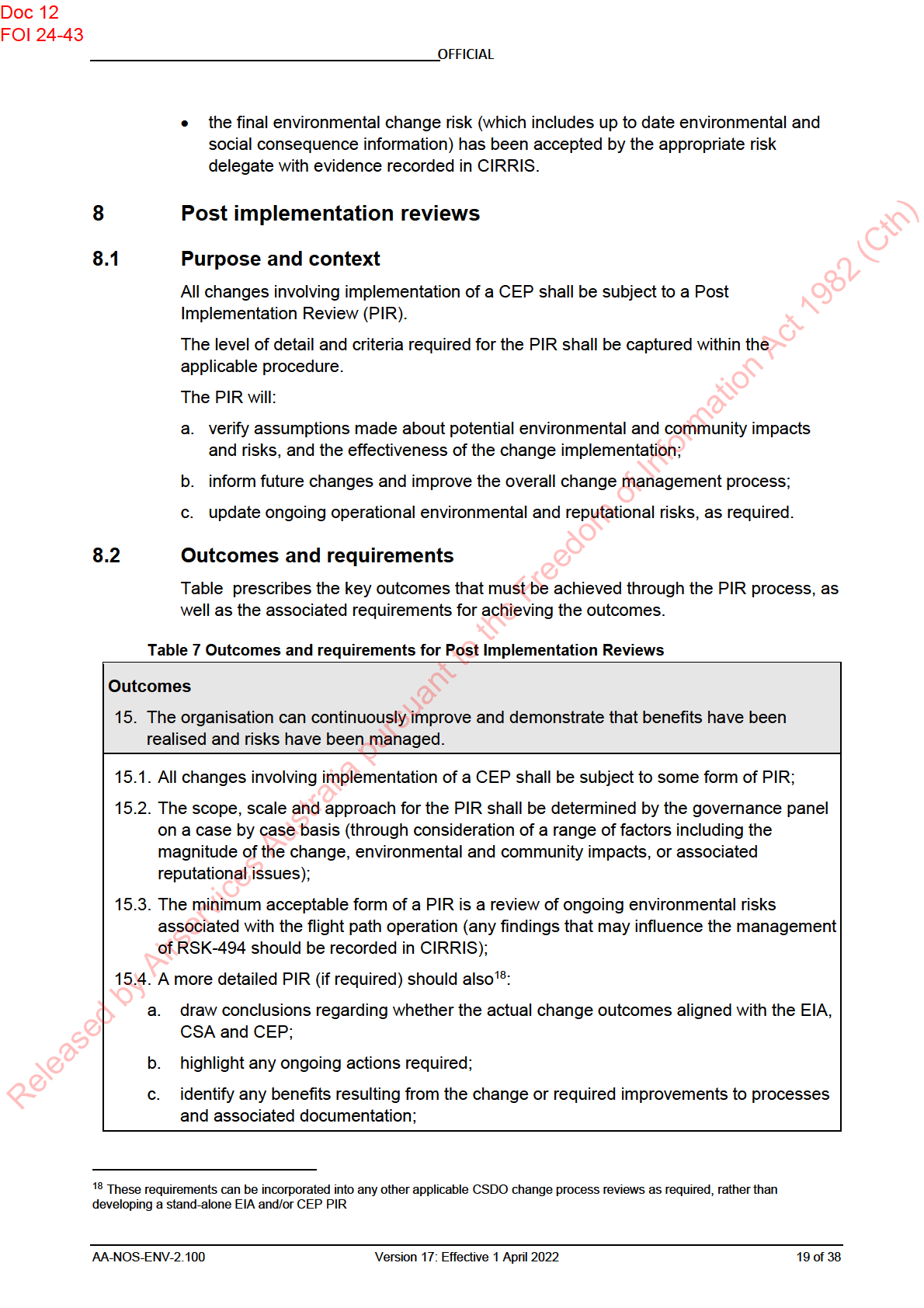
Doc 12
FOI 24-43
OFFICIAL
d. identify any opportunities for noise improvements with regards to actual operating data
and community feedback/complaints.
15.5. Where a CIRRIS action has been raised to conduct a detailed PIR, the CIRRIS change
record can be closed prior to completion of the PIR.
9
Skills, qualifications and awareness
Managers accountable for requirements described in this Standard shall:
ensure that all staff involved in environmental management of proposed changes
have the necessary skills and/or qualifications and/or access to mentoring and
coaching from appropriately experienced personnel to effectively perform their role;
implement training and/or education and/or coaching programs to build required
capabilities and experience, as required.
10
Assurance assessments
Managers accountable for requirements described in this Standard shall conduct
periodic assurance assessments to confirm that associated requirements and
obligations are being met.
Additionally, the CSRO Group shall conduct targeted assurance assessments of key
elements of the change management process on a periodic basis.
On occasion relevant regulatory and/or oversight bodies may conduct assurance
assessments on our application of this Standard.
11
Documentation and recording
All artefacts required to acquit the requirements of this Standard (including EIAs, CSAs,
risk assessments CEPs and CERs) shall:
1. be maintained on record in accordance with Airservices Records Management
Standard (AA-NOS-GOV-0004);
2. be attached in CIRRIS (in the relevant Management of Change record);
3. have key actions recorded in CIRRIS.
by Airservices Australia pursuant to the Freedom of Information Act 1982 (Cth)
Released
20 of 38
Version 17: Effective 1 April 2022
AA-NOS-ENV-2.100
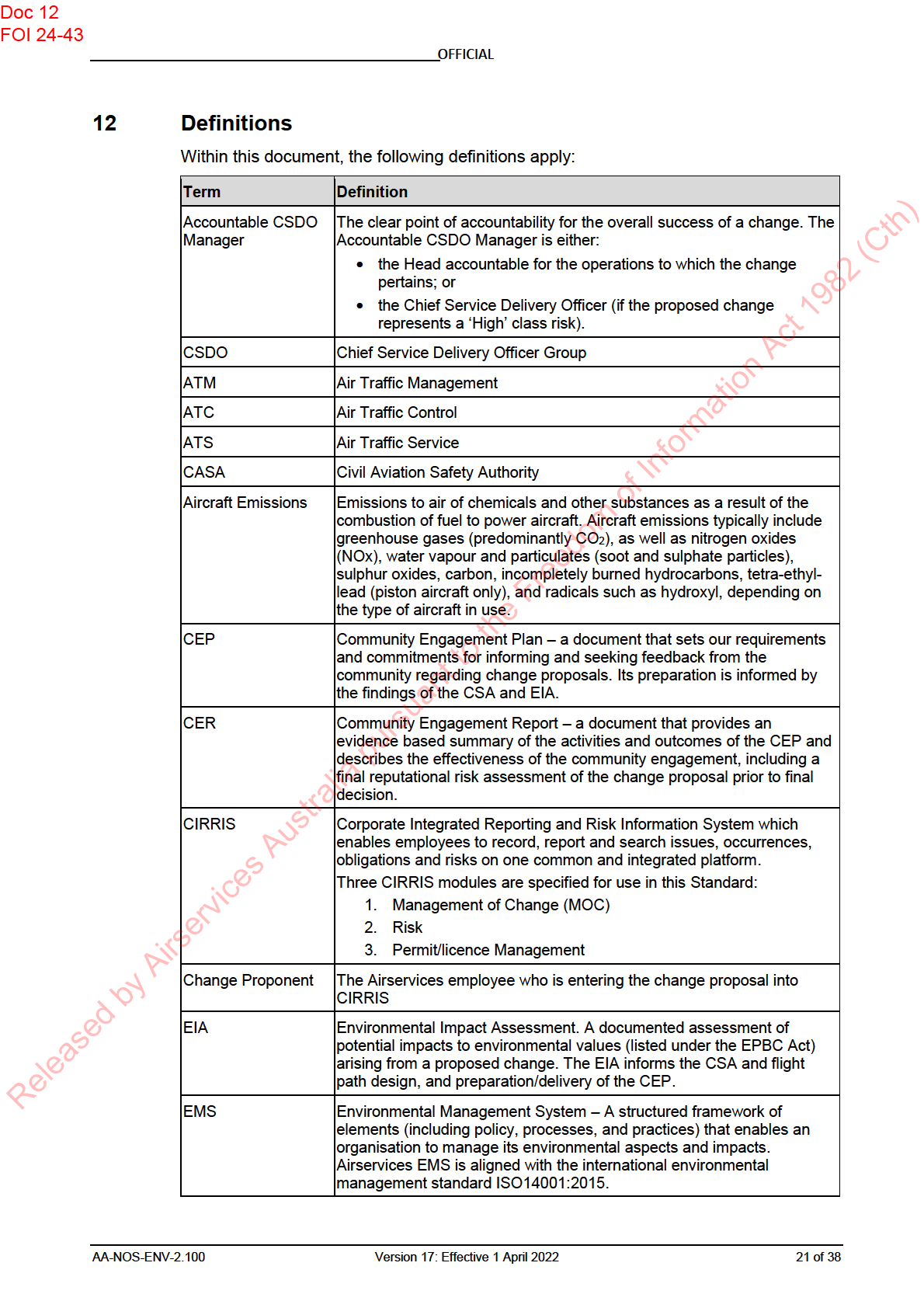
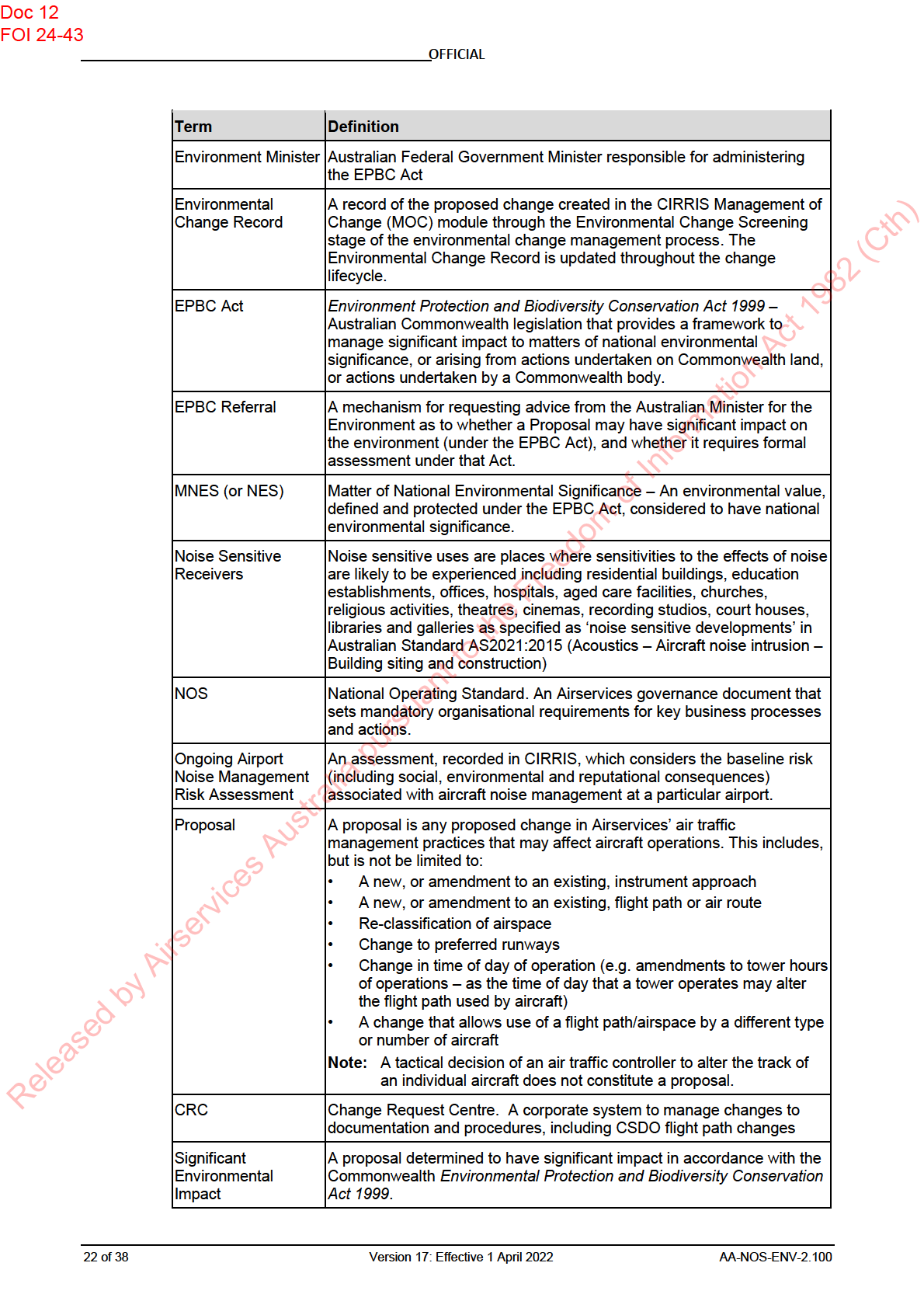
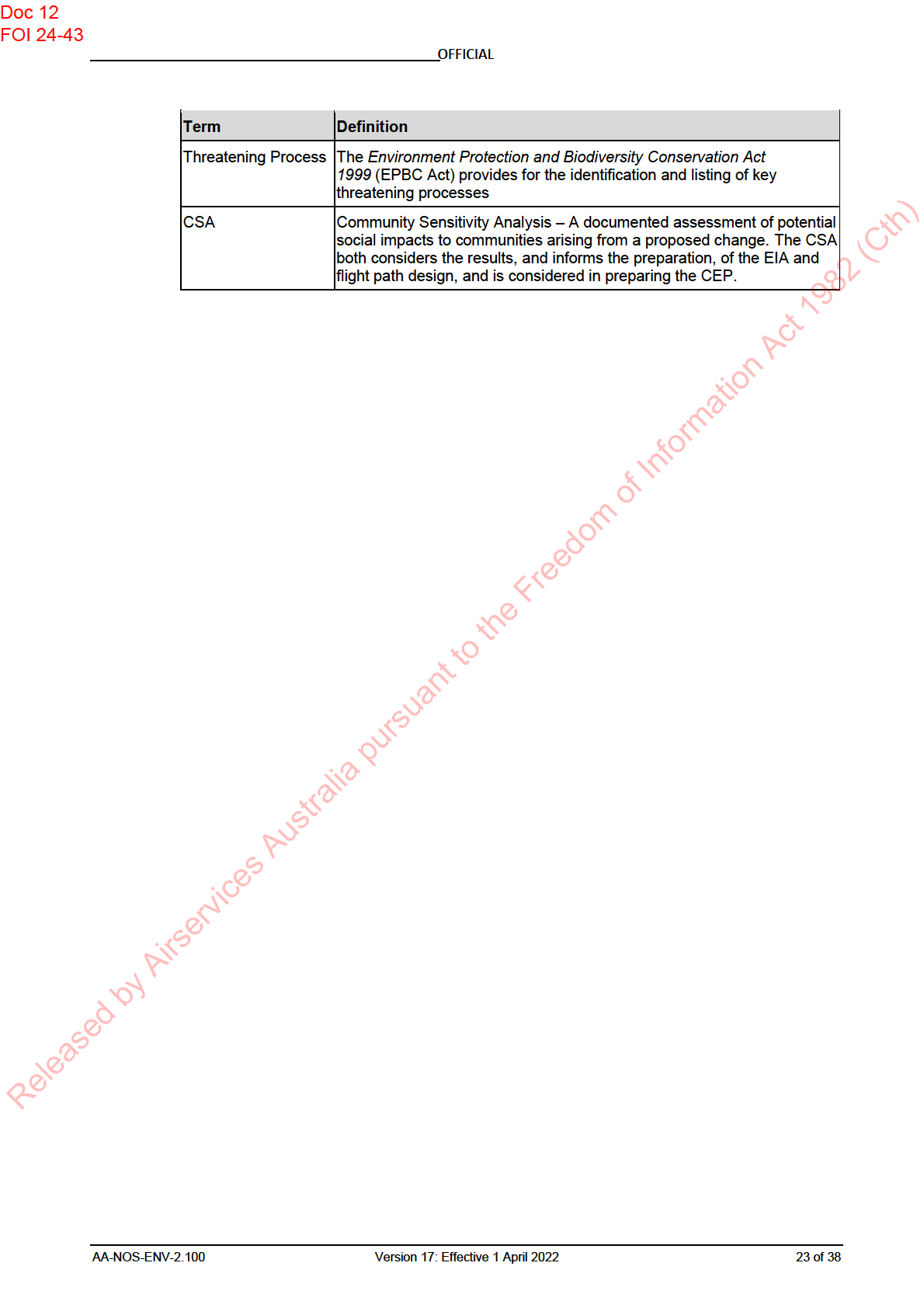
Doc 12
FOI 24-43
OFFICIAL
13
References/related documents
Internal Documents
Environment Policy: C-POL0030
Risk Management Standard: AA-NOS-RISK-0001
Environmental Risk Management Procedure: ENV-PROC-0004
Environmental Management System Objectives and Requirements –
AA-NOS-ENV-0001
Airspace Change Process: ATS-PROC-0147
National ATS Administration Manual (NAAM): ATS-MAN-0013
Community Engagement – Change to Aircraft Operations ENV-PROC-0011
Environmental Impact Assessment of Changes to Aircraft Operations: ENV-
GUIDE-0028
Environmental Assessment of Change and Regulatory Compliance Procedure:
C-PROC0313
Environment Risk Assessment Template: C-TEMP0290
Preliminary Noticeability and Sensitivity Analysis template
Community Sensitivity Analysis Template
Community Engagement Plan Template
Community Engagement Report Template
Community Engagement Framework
Flight Path Design Principles
Flight Path Design Principles report template
External Documents
SEWPaC 2010, ‘Actions on, or impacting upon, Commonwealth land, and actions
by Commonwealth agencies’ Significant impact guideline 1.2, Environment
Protection and Biodiversity Conservation Act 1999.
AS2021-2000: Acoustics – Aircraft noise intrusion – Building siting and
Construction, Standards Australia International Ltd, Sydney, NSW 2000.
Former Commonwealth Department of Transport and Regional Services
(DOTARS), Discussion Paper ‘Expanding ways to describe and assess aircraft
noise’ (March 2000).
Transport Noise Management Code of Practice – Volume 1 Road Traffic Noise,
Queensland Department of Transport and Main Roads, 2013.
by Airservices Australia pursuant to the Freedom of Information Act 1982 (Cth)
Released
24 of 38
Version 17: Effective 1 April 2022
AA-NOS-ENV-2.100
Doc 12
FOI 24-43
OFFICIAL
Appendix A
Environmental Screening Criteria
Context
The Environmental Change Screening of proposed changes to aircraft operations is
undertaken to identify those proposals that do not require further Environmental Impact
Assessment (EIA) or community engagement (including preparation of a Community
Engagement Plan (CEP)). In keeping with our risk appetite in the environmental sphere, the
criteria aim to ensure that only those proposed changes with very low risk (e.g. change
occurs at high altitude or wholly over water and distant from residential areas) are not
subject to detailed environmental assessment.
The criteria (shown in Table 1) were developed by acoustics engineers and aviation
environmental scientists. They were peer reviewed and refined by industry experts and
specialist consultants in 2018 and have been enacted for over a decade. Application of the
criteria over an extended timeframe, as well as scrutiny by external stakeholders (including
the Aircraft Noise Ombudsman), has validated and verified their appropriateness for driving
the required level of environmental assessment for proposed changes to aircraft
operations.
Explanatory notes
1. What is “new”?
A new flight path or other aircraft operation is one that is not currently being used. In
cases where a practice has emerged and it is sought to formalise it, these must still
follow the requirements of this Standard.
Where a route has become inactive due to industry decisions, but is still published and
available for use, this is not considered “new”. Changes to a published but ‘inactive’
route must still meet the screening criteria and consideration of application of the criteria
to determine any unforeseen impacts due to the ‘inactive’ nature of the route.
2. What is the baseline measurement for calculating an increase in numbers?
For the purpose of criterion C4, baseline measurements shall be derived from periods
of normal aviation activity. Where traffic numbers are reduced due to abnormal events
affecting the industry (slowdowns related to extraordinary social, economic or security-
related events), baseline traffic measurements shall refer to data for the period
immediately preceding the event.
Notwithstanding, baseline traffic numbers shall not include periods more than 24
months old19, regardless of whether a route received greater utilisation before that
period. Data which is more than two years old may not reflect the current community
experience or expectations of aircraft noise.
by Airservices Australia pursuant to the Freedom of Information Act 1982 (Cth)
The applicable standard is a representative “
busy week” – 90th percentile, including a
summer and winter scenario.
3. Changes involving the administration or facilitation of emergency operations (Bushfire
attack operations, Police Airwing, Coastwatch, other covert ops) are not required to be
Released
screened as they are considered inherently tactical.
19 Exceptions may be where due to external influences operating conditions over the preceding 24 months have been
abnormally affected
AA-NOS-ENV-2.100
Version 17: Effective 1 April 2022
25 of 38
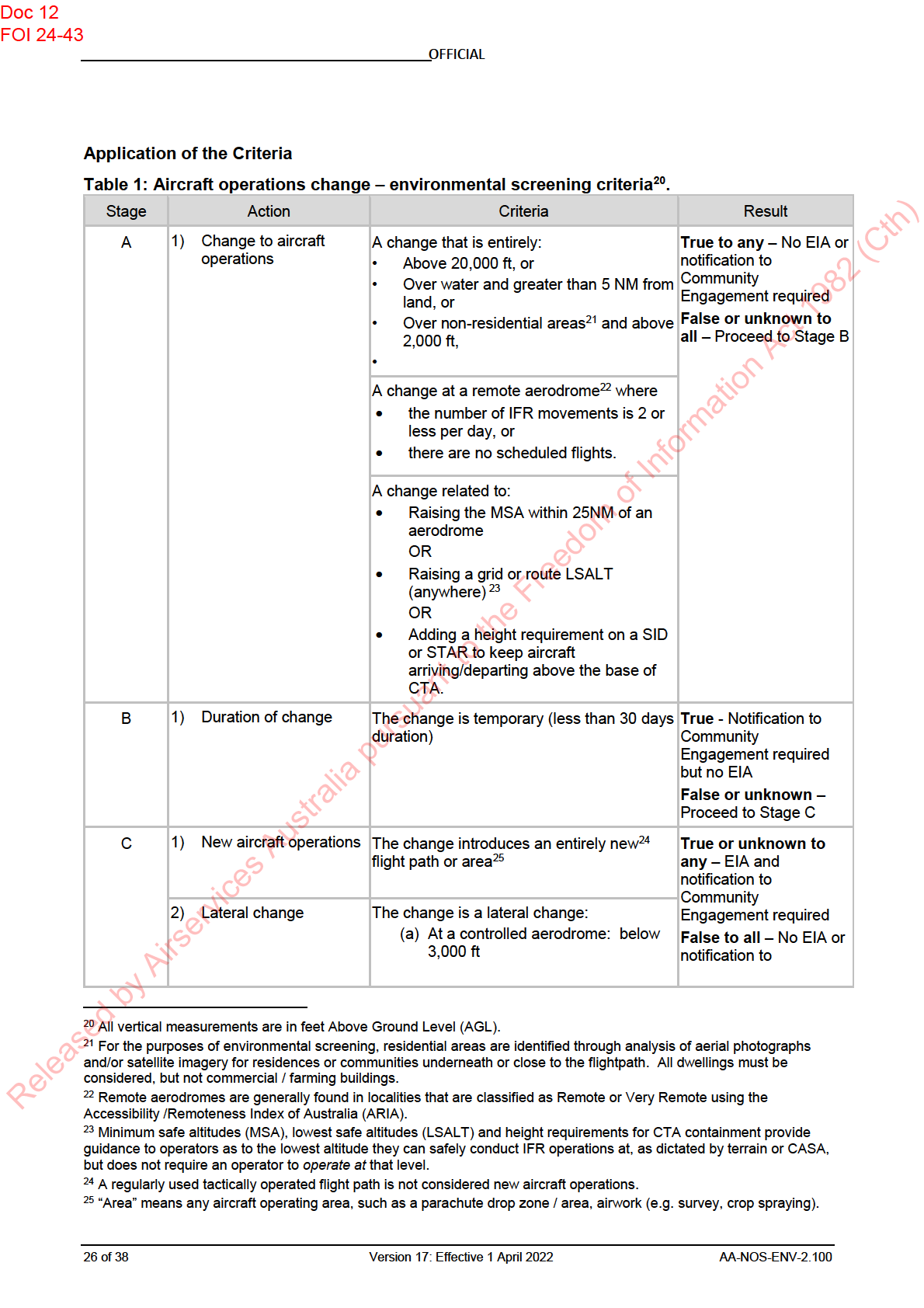
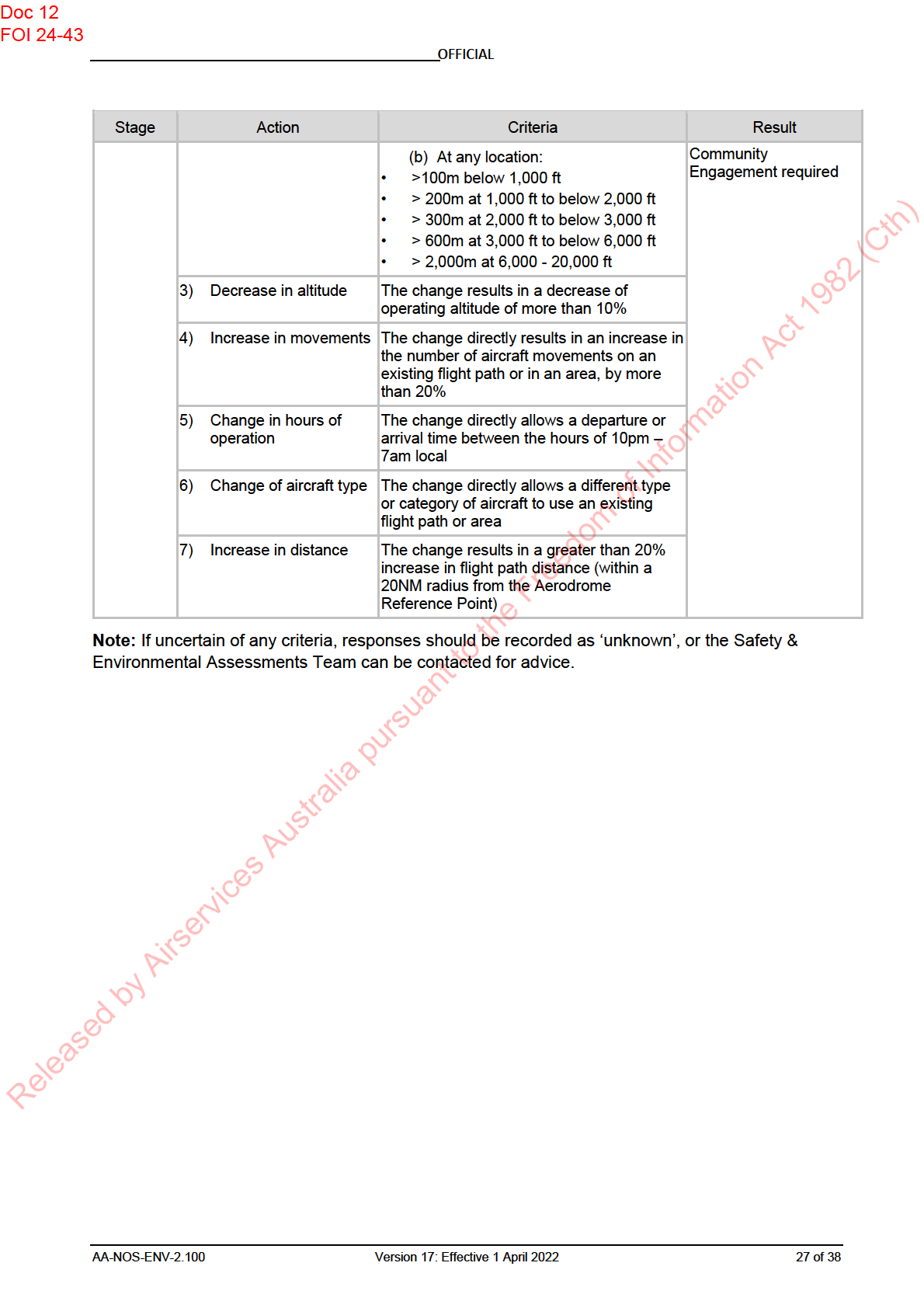
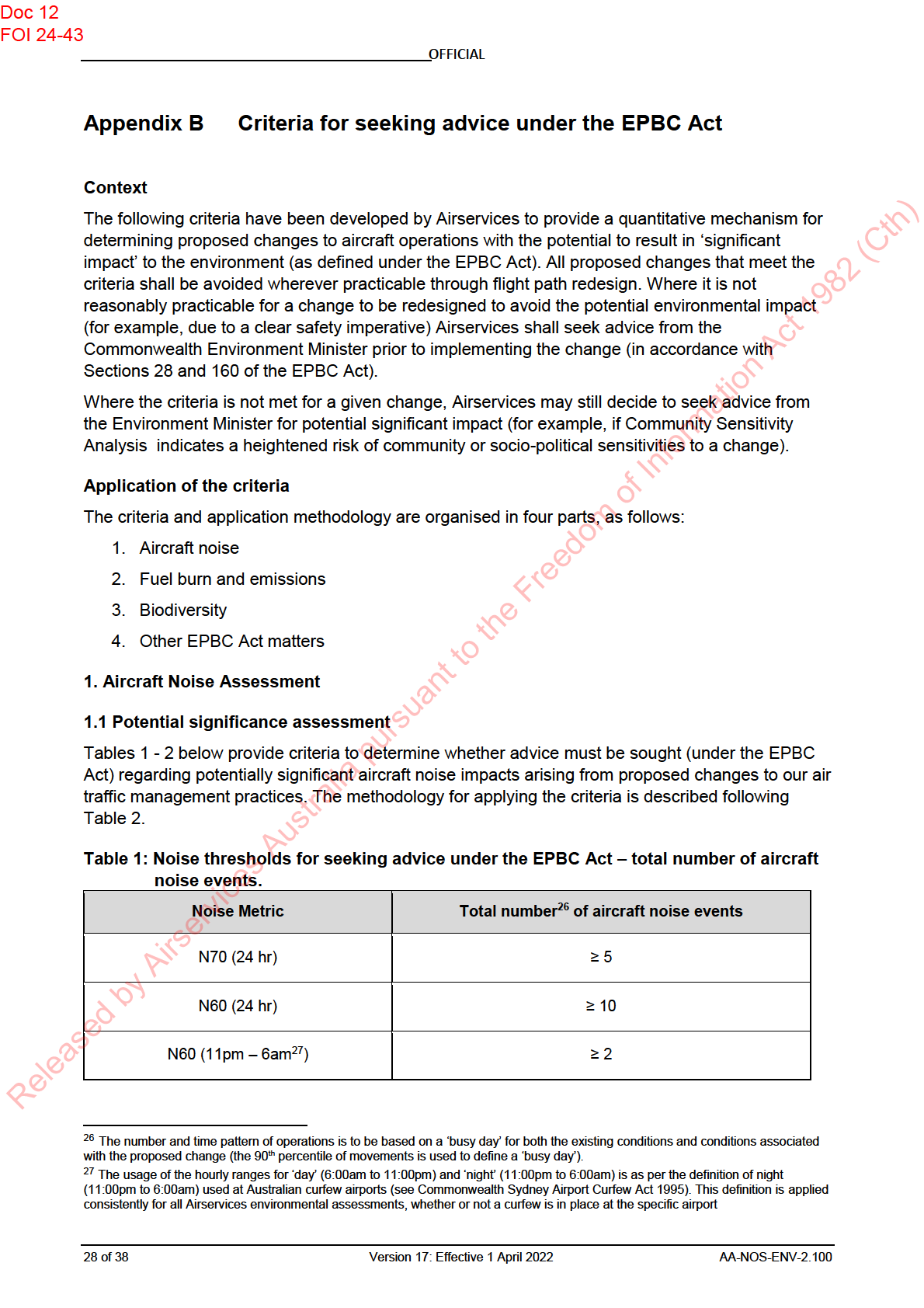
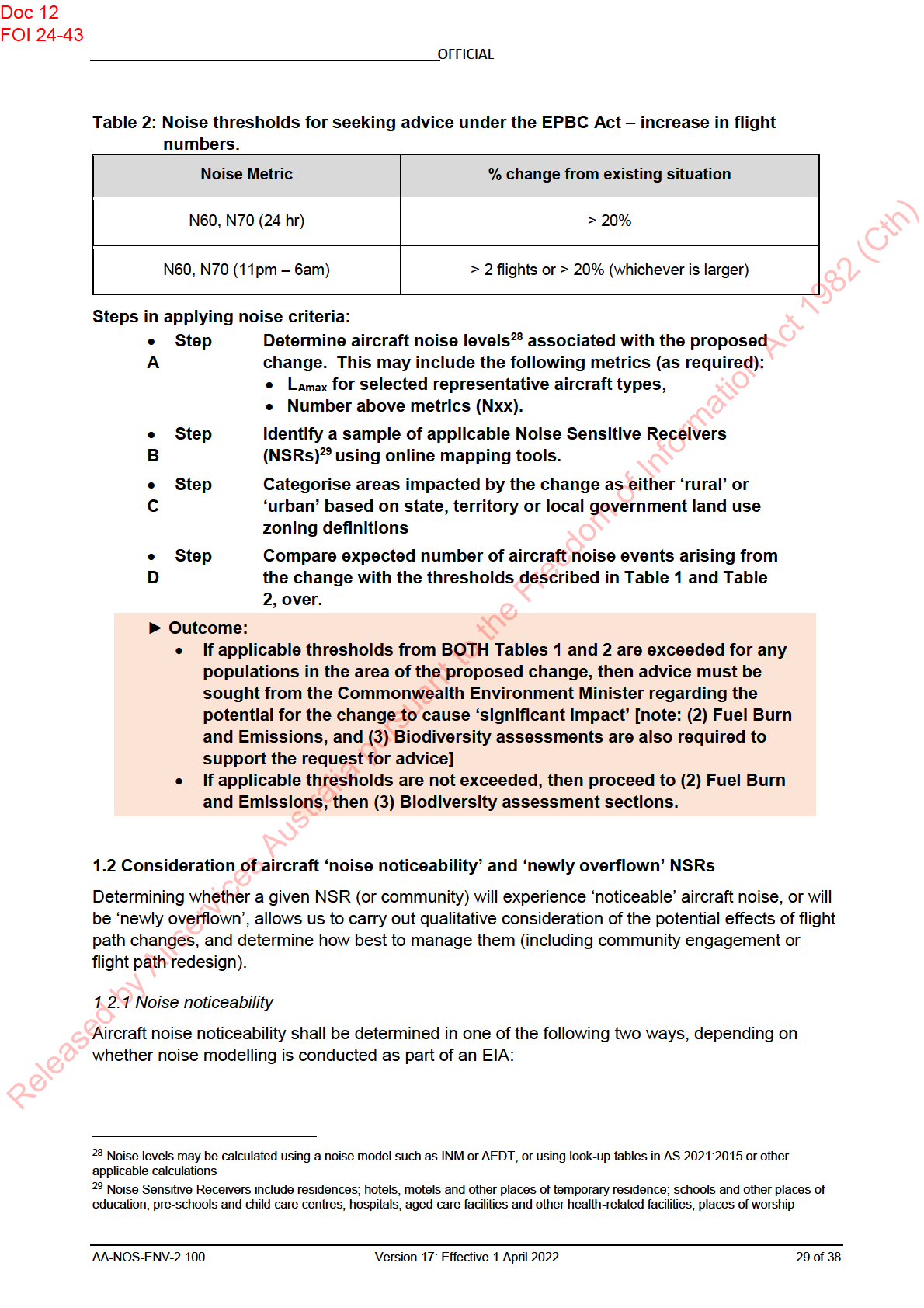
Doc 12
FOI 24-43
OFFICIAL
a) EIA with noise
50 dB(A) single event noise contours (LAmax) are modelled for
modelling
:
urban areas; and 42dB(A) contours are modelled for rural areas,
Any overflights of NSRs within the above contours are considered to
be ‘noticeable’.
b) EIA without noise
An area is identified 10km either side of the nominal flight path for
modelling:
urban areas (representative of 50dB(A) noise levels), and 20 km30
either side of the nominal flight path for rural areas (representative of
42dB(A) noise levels), up to a maximum distance of 35 nautical miles
(nm) from the relevant runway threshold,
Any overflights of NSRs within the above areas are considered to be
‘noticeable’.
Note – where part of an existing procedure remains unchanged under the proposed change, that
part of the design is excluded from noticeability modelling or the other noticeability identification
process described above.
1.2.2 Determining newly overflown NSRs
A NSR is considered to be "newly overflown" if:
The proposed change has been identified as ‘noticeable’, AND
The NSR currently experiences negligible existing aircraft noise – i.e. less than one overflight per
day, during the daytime (i.e. 6:00 am – 11:00pm) by an equivalent aircraft movement to what is
subject to assessment.
1.2.3 Outcomes of noise noticeability and newly overflown assessment
All proposed changes that are identified by the AEA team as being ‘noticeable’ or ‘newly
overflown’, must be communicated to the CE team to assist with effective, targeted community
engagement efforts.
This determination does not affect the outcomes of the ‘potential environmental significance’
assessment (described in Section 1.1 above), which shall be undertaken in all cases (where the
environmental change screening has determined an EIA is required).
2. Fuel Burn and Emissions Assessment
Table 4 provides criteria to determine whether to seek advice under the EPBC Act regarding
potentially significant environmental impacts associated with increases in aircraft fuel burn and
emissions, as a result of proposed changes to our air traffic management practices.
by Airservices Australia pursuant to the Freedom of Information Act 1982 (Cth)
30 Based on a B737 on departure, as per modelled noise levels in AS2021:2015, it has been identified that generally at
2,500m from the centre line of the track (sideline), noise levels will be approximately 60dB(A). This is the maximum
sideline distance at which 60dB(A) noise levels would be experienced. Based on geometric spreading of noise, it was
calculated that noise levels would be 50dB(A) at around 7,900m sideline and would be 42dB(A) at around 20,000m
Released
sideline. The units of 42dB(A) for rural areas and 50dB(A) for urban areas have been selected as representative of
noticeability of noise, with consideration of state and territory EPA guidelines. See GHD literature review for additional
information. Furthermore, departure noise levels were utilised as overall these are higher than for aircraft on arrival. As
such, distances of 10km for urban and 20km for rural have been used as a conservative measure for noticeability and to
account for any potential variations in aircraft levels
30 of 38
Version 17: Effective 1 April 2022
AA-NOS-ENV-2.100
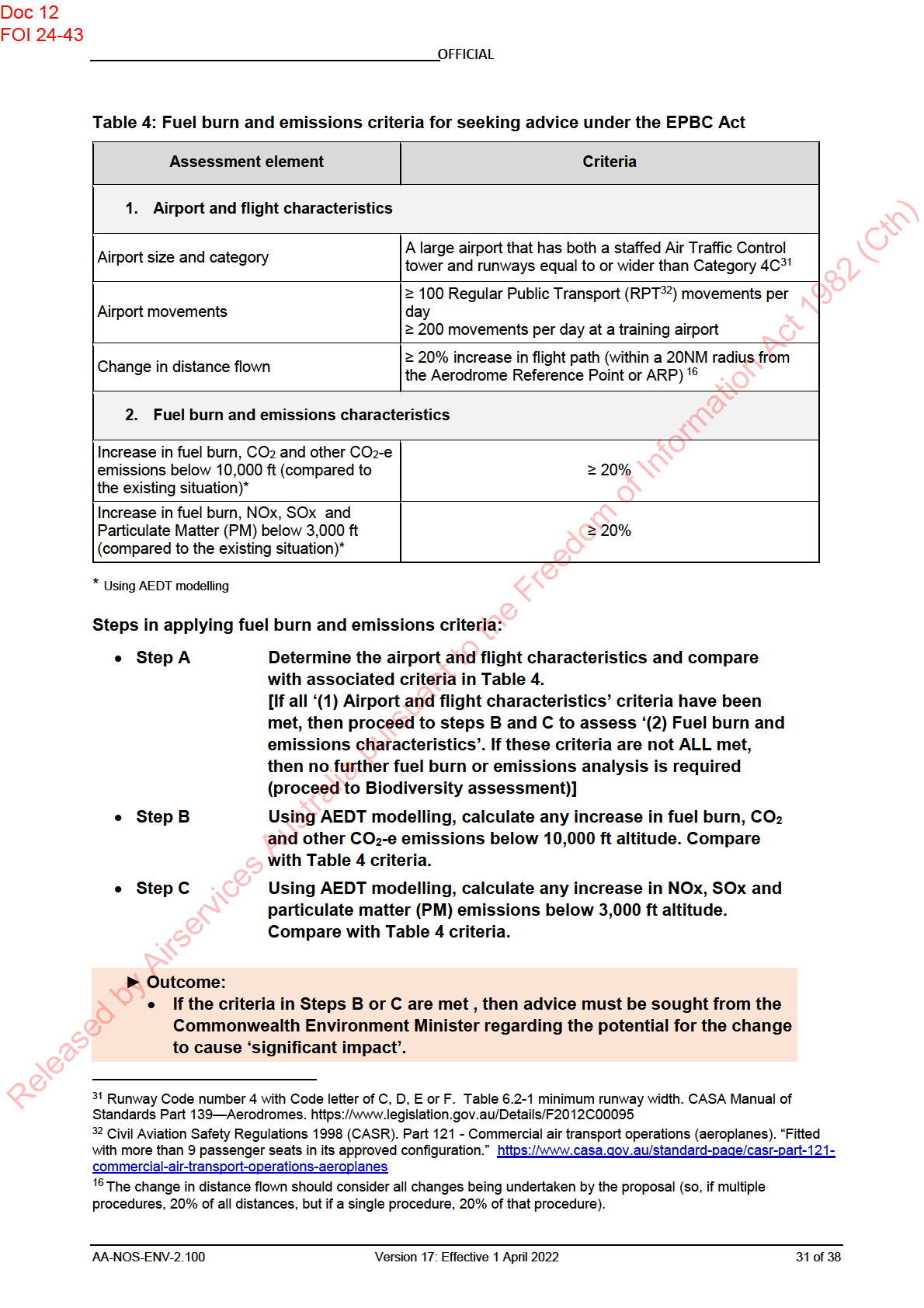
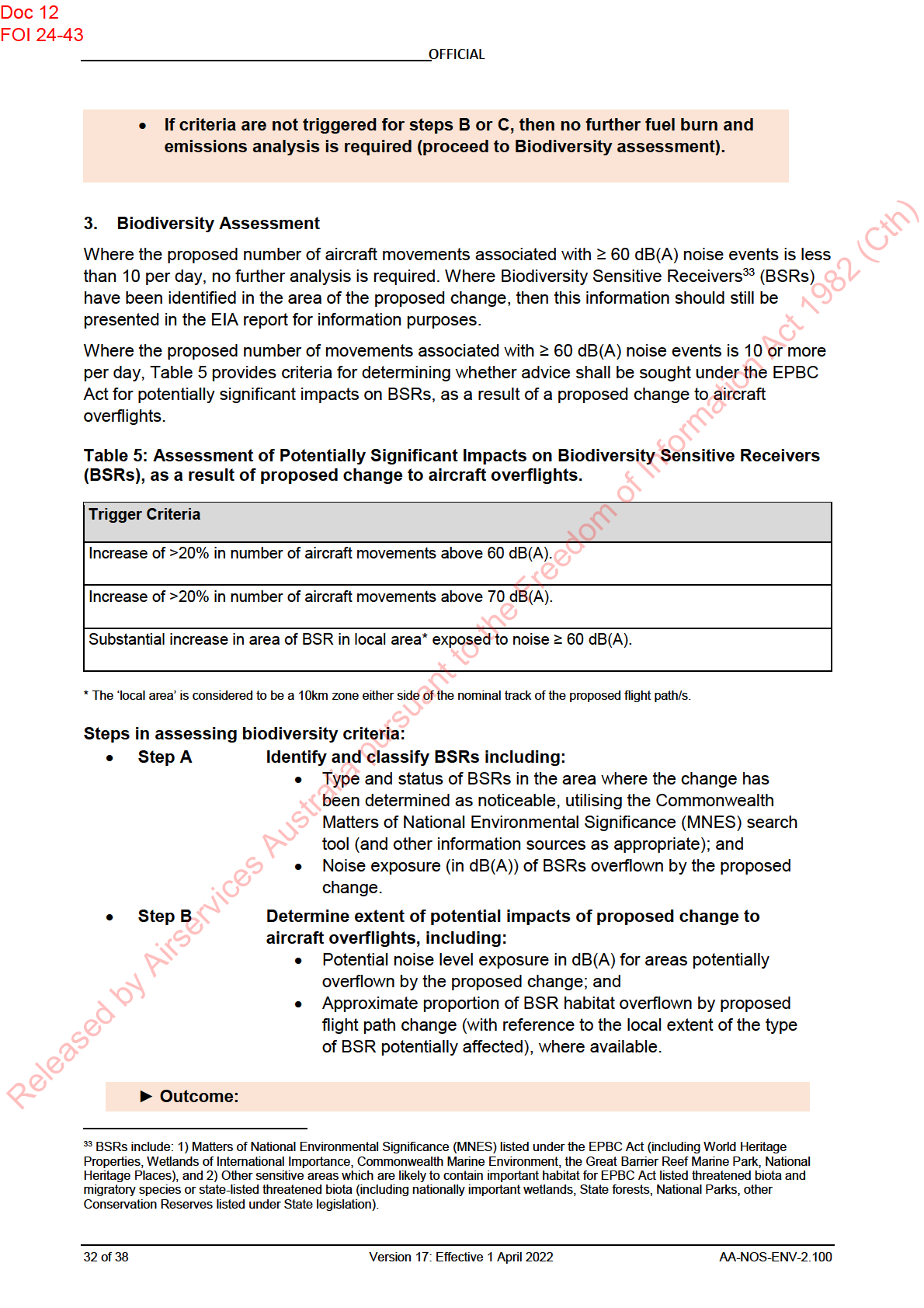
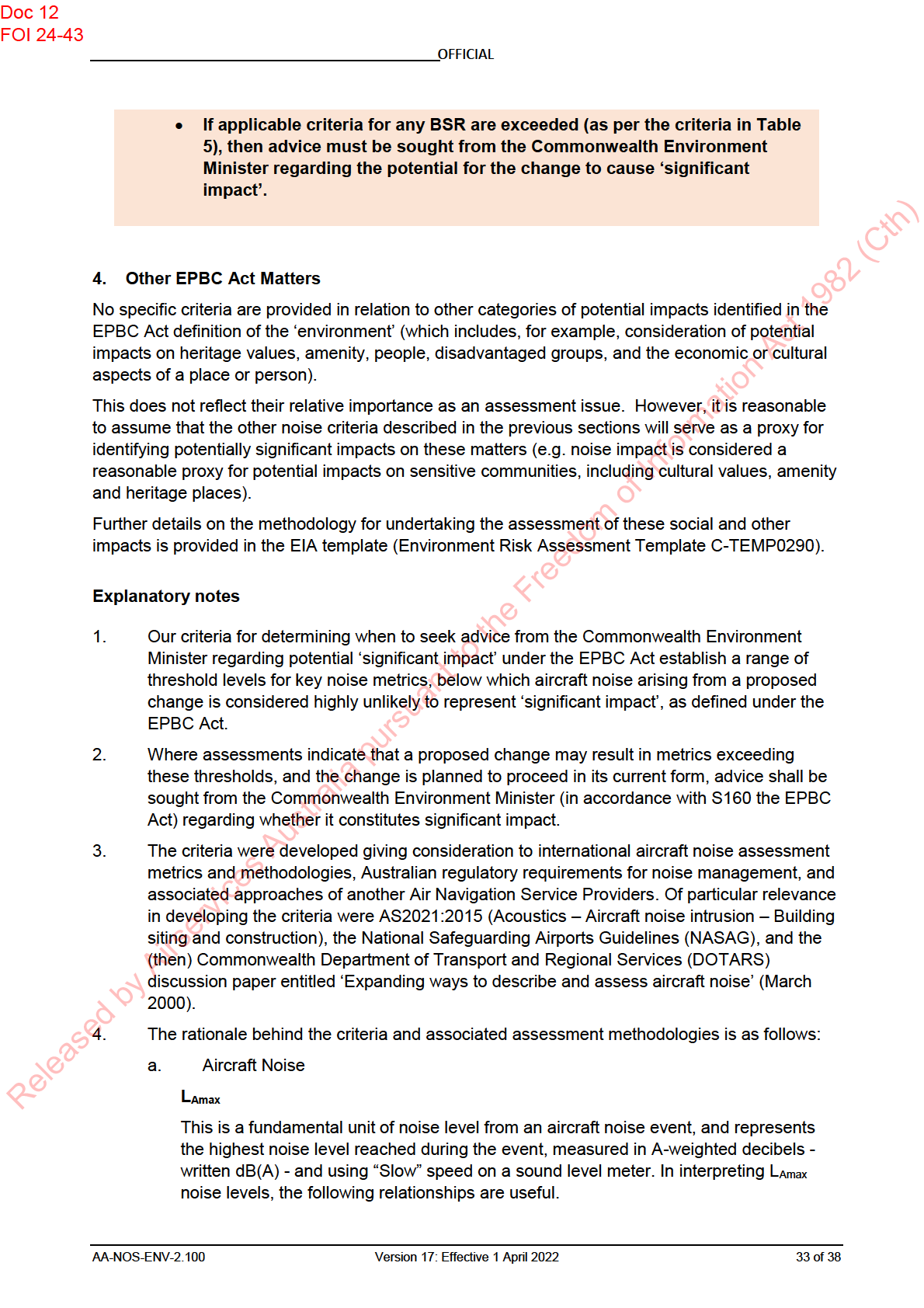
Doc 12
FOI 24-43
OFFICIAL
A noise is potentially noticeable if its LAmax level exceeds the background noise
level by more than 5 dB(A);
70dB (A) is considered to be the external sound level below which no difficulty
with reliable communication from radio, television or conversational speech is
expected in a typical room with windows open;
60 dB(A) equates to the indoor design guide level of 50 dB(A) specified in
AS2021:2015 Acoustics – Aircraft noise intrusion – Building siting and
construction for sleeping areas (with windows open)
Based on published literature34 a change in the A-weighted noise level is perceived by
the human ear as follows:
Changes of up to 3dB(A) – not likely to be perceptible.
Changes between 3dB(A) and 5dB(A) – may be perceptible.
Changes between 5dB(A) and 10dB(A) – likely to be perceptible.
‘
Number Above’ metrics
‘Number Above’ metrics (also known as ‘N Contours’) are an aircraft noise
characterisation mechanism used to map noise ‘zones’ around an aerodrome. They
show the number of noise events per day (or other time period) with LAmax levels above
a specified value. For example, N70 contours would show the number of aircraft noise
events per day with LAmax greater than 70dB(A). N70 and N60 are particularly useful as
they express the number of noise events per day that may potentially affect listening
activities or sleep respectively, as described above. Use of these metrics was first
documented in the discussion paper ‘Expanding ways to describe and assess aircraft
noise’ produced by the (then) Commonwealth Department of Transport and Regional
Services in March 2000.
These metrics are also useful in assessing the impact of a change in noise exposure,
which may involve a change in the number of events exceeding a given noise level.
The magnitude of the change can be expressed as the percentage change in N60, N70
or another relevant noise value. For further information refer to:
https://infrastructure.gov.au/aviation/environmental/transparent noise/expanding/4.asp
x)
Noticeability
The noticeability of a noise depends fundamentally on the relationship between the
highest noise level achieved (LAmax) and the existing background noise level. The
Noticeability methodology was developed with consideration of thresholds from
Australian state and territory regulations for industrial noise. Noise noticeability is
intended to identify NSRs which may notice changes in noise levels and therefore
should be considered for community engagement (even if not considered ‘potentially
by Airservices Australia pursuant to the Freedom of Information Act 1982 (Cth)
significant under the EPBC Act). Where required population and dwelling counts may
be included as part of the noticeability assessment for the purposes of community
engagement.
b.
Fuel Burn and Emissions
Released
34 For example, Transport Noise Management Code of Practice – Volume 1 Road Traffic Noise, Queensland Department of Transport
and Main Roads 2013.
34 of 38
Version 17: Effective 1 April 2022
AA-NOS-ENV-2.100
Doc 12
FOI 24-43
OFFICIAL
i.
Following a process outlined in ICAO 201135, which provides information on
common thrust settings and estimates of time-in-mode, and FAA 200036, using a
height-weighting factor for various stages of flight, it is estimated that the taxiing
of aircraft can account for as much as 90% of ground level emissions (i.e.. the
landing and take-off (LTO) cycle accounts for about 10% of aircraft emissions
during an entire flight). Further, FAA 2000 demonstrates that emissions from
aircraft at 3,000 ft have an impact on ground level pollutant concentrations two
orders of magnitude lower than emissions at 100 ft.
ii.
Aircraft emissions in the LTO cycle below 3,000ft (apart from taxiing emissions)
may have an impact on human health, as per ICAO:
https://www.icao.int/environmental-protection/Pages/local-air-quality.aspx
iii.
At the time of writing, the Australian Government did not have a policy regarding
increases in aviation CO2 emission that could be used for guidance in
establishing criteria for potential significance. Therefore a nominal figure of a
20% increase has been used (per proposed change).
c.
Biodiversity
i.
A recent review of 20 years of international research documenting the effects of
anthropogenic noise on wildlife37, including aircraft noise, has found the
following:
o
The range of noise levels reported to induce annoyance in humans and
responses in terrestrial wildlife are similar, ie. 40-100 dB(A).
o
Noise sensitivity varies greatly and there is large variability in responses
to noise between species and individuals and at different locations.
o
Some species are more susceptible to disturbance from noise than
others because of auditory capabilities, social structure, life history
patterns or habitat.
o
While some species may develop a tolerance when overflights are
frequent or regular, others do not.
o
Physiological and fitness effects in wildlife have been documented at
noise exposure levels from 52 dBA for certain species (in particular
songbirds).
ii.
The noise level threshold of 60 dBA adopted for the criteria represents a
reasonably conservative noise threshold based on the findings of the published
literature (i.e. this threshold captures 60% of studies that have shown adverse
responses in terrestrial wildlife, including impacts on physiology and fitness) and
by Airservices Australia pursuant to the Freedom of Information Act 1982 (Cth)
given the large variability in responses between species and individuals and at
different locations.
35 ICAO (2011): Airport Air Quality Manual. Doc 9889, First Edition 2011
Released
36 FAA (2000). Consideration of Air Quality Impacts by Airplane Operations at or Above 3000 feet AGL. Federal Aviation
Administration, FAA-AEE-00-01 DTS-34, September 2000
.
37 Shannon, G., McKenna, M.F., Angeloni, L. M., Crooks, K. R., Fistrup, K. M., Brown, E., Warner, K. A., Nelson, M. D., White, C.,
Briggs, J., McFarland, S., and Wittemyer, G. (2016). A synthesis of two decades of research documenting the effects of noise on
wildlife.
Biological Reviews 91: 982-1005.
AA-NOS-ENV-2.100
Version 17: Effective 1 April 2022
35 of 38
Doc 12
FOI 24-43
OFFICIAL
iii.
Biodiversity Sensitive Receivers (BSRs), are areas protected under the EPBC
Act or other areas that are likely to contain important habitat and are used as a
proxy for EPBC Act listed threatened biota and migratory species and state-
listed threatened biota.
iv.
BSRs should be located and classified over at least a 10km buffer around the
proposed flight path/s to enable a comparison of the area of BSR affected by a
change in noise with the extent of BSR in the locality.
v.
The 10km buffer area in (iv) is consistent with the definition of ‘locality’ for EPBC
Act Protected Matter Searches.
5.
Impact Assessment Methodology
The EMS has included criteria for determining significant impact under the EPBC Act, since
2013 to the present, over which time the associated metrics and methodologies have been
validated through:
a.
discussion of changes being implemented at Community Aviation Consultation
Group (CACG) meetings at airports around Australia;
b.
ongoing analysis of aviation noise complaint data, and associated flight path
changes, from the Noise Complaints Information Service (NCIS);
c.
consultation with stakeholders (including the Aircraft Noise Ombudsman and the
Commonwealth Department of Infrastructure and Regional Development and Cities)
regarding noise complaints and noise impact assessments;
d.
a referral to the Commonwealth Department of Environment and Energy, under the
EPBC Act, for the Gold Coast Airport Instrument Landing System (ILS) Project
(which included discussion of the criteria and associated methodology to assess
potential significance of aviation noise impacts).
Over 200 airspace changes have been assessed for potential aviation noise impacts and
implemented by us since 2013, without later being found to represent ‘significant impact’
under the EPBC Act. Given this result, and the significant traffic growth experienced in
Australia since 2013, our assessment methodologies (and the criteria) can be seen to be
appropriate and relatively conservative.
6.
Continuous Improvement of the Criteria
As part of our continuous improvement efforts (and in response to feedback from the
Aircraft Noise Ombudsman), the significance criteria were reviewed and updated in 2018,
with the assistance of an external specialist consultant. As a result, a number of revisions
were made to the criteria in 2019: to more comprehensively address environmental values
under the EPBC Act; formally introduce concepts of ‘noise noticeability’; and to improve the
by Airservices Australia pursuant to the Freedom of Information Act 1982 (Cth)
clarity of the environmental assessment methodology. This process also involved
consultation with the Commonwealth Department of Environment and Energy (DoEE), and
the Department of Infrastructure, Regional Development and Cities (DIRDC), regarding the
appropriateness and rigour of the criteria, and its overall environmental impact assessment
process (for changes to air traffic management practices).
Released
36 of 38
Version 17: Effective 1 April 2022
AA-NOS-ENV-2.100
Doc 12
FOI 24-43
OFFICIAL
Definitions
o ‘Existing flight’ refers to any flight path that is either formalised or regularly used.
Formalised flight paths could include:
Noise Abatement Procedures (NAPs), or flight paths prescribed in
Letters of Agreement (LoAs) with locals operators.
Instrument Flight Procedures (IFPs), such as Standard Instrument
Departures (SIDs), Standard Approach Routes (STARs), and other
approach procedures published in the Aeronautical Information
Publications (AIP) Departure and Approach Procedures (DAP) plates.
Regional Routes and Domestic Routes published in the Designated
Airspace Handbook (DAH).
o Non-formalised paths could include a regularly used vectoring path or track
shortening. Regular usage is subjective to each individual airport and can
include seasonal variations. For example a path that is only used during certain
meteorological conditions, but is used consistently in those situations, would be
considered an existing track.
Commonwealth Matters of National Environmental Significance (MNES) sites: sites that
represent Matters of National Environmental Significance – as listed in the EPBC
Protected Matters Search Tool.
Names and definitions for ‘rural’ and ‘urban’ will differ between councils and districts
throughout Australia, but there are generally similar zones corresponding to these.
Where there is doubt, advice should be sought from the local planning body.
The usage of the terms ‘day’ (6:00am to 11:00pm) and ‘night’ (11:00pm to 6:00am) is
as per the definition of night (11:00pm to 6:00am) used at Australian curfew airports
(see Commonwealth Sydney Airport Curfew Act 1995). We apply this definition
consistently for all environmental assessments, whether or not a curfew is in place at
the specific airport
by Airservices Australia pursuant to the Freedom of Information Act 1982 (Cth)
Released
AA-NOS-ENV-2.100
Version 17: Effective 1 April 2022
37 of 38
Doc 12
FOI 24-43
OFFICIAL
Appendix C
Other Business Revenue – explanatory notes
Other Business Revenue (OBR), otherwise referred to as ‘Unregulated Revenue’ or
Non-Airways Revenue, relates to the provision of goods or services other than those
which are provided by us as part of the regulated service that is subject to the Long
Term Pricing Agreement (LTPA) with customers. For the avoidance of any doubt, OBR
is a term applied to account for those Airservices activities not funded through Airways
Revenue.
OBR includes (but is not limited to):
provision of charting services and other publications
maintenance or provision of navaids under contract
provision of air traffic services under contract (eg. for Solomon
Islands and Nauru)
delivery of training, and
funds received for official development assistance (aid) activities.
For further information on OBR, refer to C-PROC0194
by Airservices Australia pursuant to the Freedom of Information Act 1982 (Cth)
Released
38 of 38
Version 17: Effective 1 April 2022
AA-NOS-ENV-2.100
























